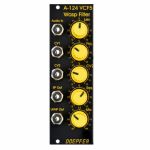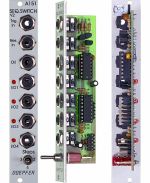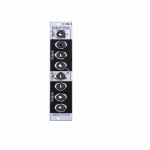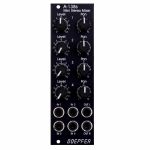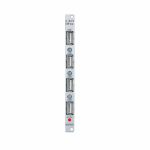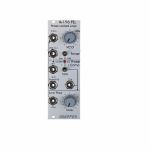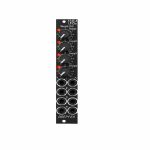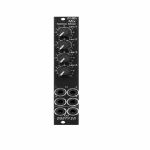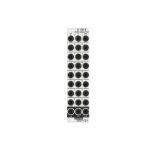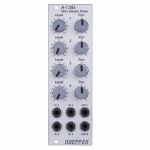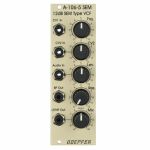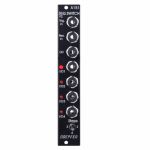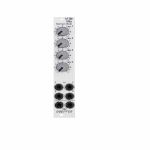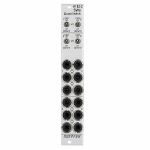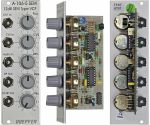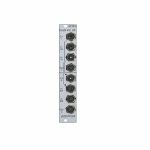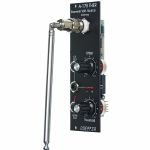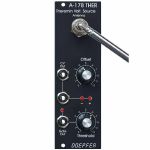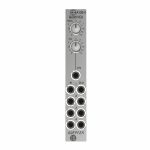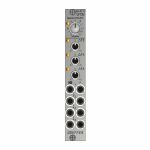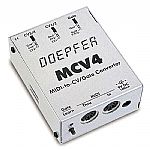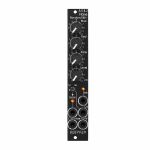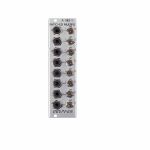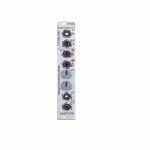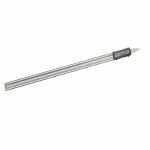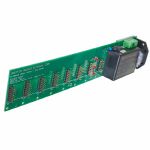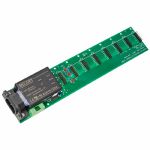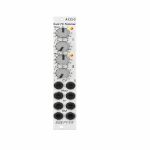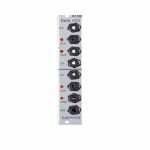100% Secure Shopping
Studio equipment
Our full range of studio equipment from all the leading equipment and software brands. Guaranteed fast delivery and low prices.
100% Secure Shopping
DJ equipment
Our full range of DJ equipment from all the leading equipment and software brands. Guaranteed fast delivery and low prices. Visit Juno DJ
Filter
Stock
Coming Soon
Equipment
Format
Brand
Featured
Price
Tags
Doepfer A-124 VCF5 Wasp Filter 12dB Multimode Filter Module (special edition, black/yellow) (filter synth module)
Cat: 671564 Rel: 29 Nov 17 • View all Synth modules
12dB multi-mode filter with unique classic circuitry, based on the filter from the 70s EDP Wasp synth
Notes: Module A-124 is a special 12dB multimode filter using the "strange" filter circuit of the "EDP Wasp" (an analog synthesizer with black/yellow case built end of the seventies, manufactured by the UK company "Electronic Dream Plant" with Chris Huggett und Adrian Wagner). This design "abuses" digital inverters as analog operational amplifiers leading to distortions and other "dirty" effects that generate the specific sound of this filter. The filter is equipped with a band pass output and a combined low/notch/high pass output. For this output a control knob defines the relation between low and high pass signal. If both signals appear at the same level (i.e. middle position of the Mix knob) one obtains a notch filter. Otherwise the low or high pass signal predominates. The module does not feature self-oscillation in contrast to most of the other filters of the A-100 system.
Inputs: Audio In, CV In (2x)
Outputs: Bandpass Out, Low/Highpass Mix-Out
Controls: Audio and CV attenuator, Frequency, Resonance, LP/HP Mix
The function and operation of this module is very similar to the module SEM VCF A-106-5. But the sound of both filters is very different! The only functional difference is the position of the sockets and controls, and the function of the controls CV2 (A-124: normal attenuator, A-106-5: polarizer).
- 3U Eurorack module, 8HP wide, 45mm deep
- Current draw 30mA
… Read moreInputs: Audio In, CV In (2x)
Outputs: Bandpass Out, Low/Highpass Mix-Out
Controls: Audio and CV attenuator, Frequency, Resonance, LP/HP Mix
The function and operation of this module is very similar to the module SEM VCF A-106-5. But the sound of both filters is very different! The only functional difference is the position of the sockets and controls, and the function of the controls CV2 (A-124: normal attenuator, A-106-5: polarizer).
- 3U Eurorack module, 8HP wide, 45mm deep
- Current draw 30mA
8 in stock $78.88
Click for better price!
or call +44 20 7424 1960
quote 671564
quote 671564
Doepfer A-151 Quad Sequential Switch Module (silver) (switch/quad synth module)
Cat: 577792 Rel: 06 Jun 19 • View all Synth modules
Electronic switch with up to four steps - 4HP
Notes: Module A-151 (Quad Sequential Switch) is like an electronic four-position rotary switch.
It includes trigger and reset inputs, four in / outputs, and a common out / input. Each time a pulse is received at the trigger input socket, the common out / input is connected to the next in / output. After the fourth in / output, the next trigger makes it step back to the first again, and so on. A positive pulse at the reset input switches the out / input immediately back to the first in / output (see Fig. 1). Voltages in the range -8V...+8V at the O/I resp. I/O sockets can be processed by the module.
Four LEDs indicate the active in / output (i.e. the on that is connected to the out / input at any particular time).
… Read moreIt includes trigger and reset inputs, four in / outputs, and a common out / input. Each time a pulse is received at the trigger input socket, the common out / input is connected to the next in / output. After the fourth in / output, the next trigger makes it step back to the first again, and so on. A positive pulse at the reset input switches the out / input immediately back to the first in / output (see Fig. 1). Voltages in the range -8V...+8V at the O/I resp. I/O sockets can be processed by the module.
Four LEDs indicate the active in / output (i.e. the on that is connected to the out / input at any particular time).
4 in stock $58.12
Click for better price!
or call +44 20 7424 1960
quote 577792
quote 577792
Doepfer A-119 External Input Envelope Follower Module (silver) (external/envelope follower/preamp/controller/comparator synth module)
Cat: 577771 Rel: 29 Nov 17 • View all Synth modules
Envelope follower & pre-amplifier for microphone/line-signals - 8HP
Notes: Module A-119 (External Input / Envelope Follower) is designed to allow external audio signals to be integrated into the System A-100. It comprises a pre-amp, envelope follower, and comparator.
The pre-amp has two inputs: an unbalanced input for line level signals, with a gain factor of from 0 to 20, and a balanced input with a gain factor of from 0 to 500, for insertion of low level signals, for instance from a microphone or electric guitar.
The Envelope Follower reads the signal level of the input, and puts out a proportional voltage as an envelope at its own output.
The comparator generates a gate signal whenever the input goes above an adjustable trigger threshold.
Three LED's help you keep track of overload, the envelope, and the gate signal.
… Read moreThe pre-amp has two inputs: an unbalanced input for line level signals, with a gain factor of from 0 to 20, and a balanced input with a gain factor of from 0 to 500, for insertion of low level signals, for instance from a microphone or electric guitar.
The Envelope Follower reads the signal level of the input, and puts out a proportional voltage as an envelope at its own output.
The comparator generates a gate signal whenever the input goes above an adjustable trigger threshold.
Three LED's help you keep track of overload, the envelope, and the gate signal.
5 in stock $67.46
Click for better price!
or call +44 20 7424 1960
quote 577771
quote 577771
Doepfer A-180-3 Dual Buffered Multiple Module (silver) (dual/stereo/multiple synth module)
Cat: 751720 Rel: 23 Oct 19 • View all Synth modules
Dual buffered 1-in-3 multiple module - 4HP
Notes: Module A-180-3 is a dual buffered 1-in-3 multiple. The signal applied to the input socket appears as a buffered signal at the three output sockets. Each output has its own buffer, i.e. the three output sockets are not simply connected to each other. The lower output of the upper unit is normalled in the factory to the input of the lower unit. That way the module works as a single 1-in-6 buffered multiple provided that no signal is applied to the input of the lower unit. But it's also possible to pick-up the bus CV and normalize the input socket of the lower unit to the bus CV.
Application: copying/buffering of CV, gate and audio signals.
… Read moreApplication: copying/buffering of CV, gate and audio signals.
out of stock $51.89
Doepfer A-160-2 Clock/Trigger Divider II Module (silver) (clock modulator/frequency divider synth module)
Cat: 671576 Rel: 29 Nov 17 • View all Synth modules
Enhanced clock divider with multiple dividing factors - 4HP
Notes: Module A-160-2 is an enhanced version of the standard clock divider A-160. The module is a frequency divider for clock/trigger/gate signals, designed to be a source of lower frequencies, particularly for rhythm uses. The Clock input will take any digital signal from, eg. LFO, MIDI sync, or the gate from a MIDI-CV interface. At the outputs, you have access to three sets of seven different sub-divided clock signals, from half the clock frequency down to 1/128. The low/high levels of the output signals are 0V and about +10V.
The A-160-2 also has a reset input. Whenever a reset signal is sensed, all outputs are set to certain levels which depend upon the selected mode.
These are the most important features of the module:
Three different sets of dividing factors, selected by a three-position switch at the front panel:
- Power of two: 2, 4, 8, 16, 32, 64, 128
- Prime numbers: 2, 3, 5, 7, 11, 13, 17
- Integer: 2, 3, 4, 5, 6, 7, 8
Two output modes, selected by a two-position switch at the front panel:
- Gate mode: outputs act like the outputs of typical binary dividers
- Trigger mode: in this mode the outputs are AND-wired with the clock signal (i.e. the clock pulsewidth affects the pulsewidth of the outputs)
- Clock edge type selected by a jumper on the pc board:
- Positive: the rising edge of the clock signal triggers the state change of the outputs
- Negative: the falling edge of the clock signal triggers the state change of the outputs
Reset behaviour by two jumpers on the pc board:
- Level triggered: the level at the Reset input triggers the Reset
- Edge triggered: the edge of the signal at the Reset input triggers the Reset
- Positive: a high level (> 2.5V) or the rising edge at the Reset input triggers the Reset
- Negative: a low level (< 1 V) or the falling edge at the Reset input triggers the Reset
Output polarity selected by a jumper on the pc board:
- Positive: non-inverted outputs
- Negative: all seven outputs are inverted
Width: 4HP / 20mm
Depth: 35mm (Measured from the rear side of the front panel)
Current: +12V: +50mA, -12V: -0mA
… Read moreThe A-160-2 also has a reset input. Whenever a reset signal is sensed, all outputs are set to certain levels which depend upon the selected mode.
These are the most important features of the module:
Three different sets of dividing factors, selected by a three-position switch at the front panel:
- Power of two: 2, 4, 8, 16, 32, 64, 128
- Prime numbers: 2, 3, 5, 7, 11, 13, 17
- Integer: 2, 3, 4, 5, 6, 7, 8
Two output modes, selected by a two-position switch at the front panel:
- Gate mode: outputs act like the outputs of typical binary dividers
- Trigger mode: in this mode the outputs are AND-wired with the clock signal (i.e. the clock pulsewidth affects the pulsewidth of the outputs)
- Clock edge type selected by a jumper on the pc board:
- Positive: the rising edge of the clock signal triggers the state change of the outputs
- Negative: the falling edge of the clock signal triggers the state change of the outputs
Reset behaviour by two jumpers on the pc board:
- Level triggered: the level at the Reset input triggers the Reset
- Edge triggered: the edge of the signal at the Reset input triggers the Reset
- Positive: a high level (> 2.5V) or the rising edge at the Reset input triggers the Reset
- Negative: a low level (< 1 V) or the falling edge at the Reset input triggers the Reset
Output polarity selected by a jumper on the pc board:
- Positive: non-inverted outputs
- Negative: all seven outputs are inverted
Width: 4HP / 20mm
Depth: 35mm (Measured from the rear side of the front panel)
Current: +12V: +50mA, -12V: -0mA
2 in stock $97.56
Click for better price!
or call +44 20 7424 1960
quote 671576
quote 671576
Doepfer A-138sv Mini Stereo Mixer Vintage Edition Module (black) (dual/stereo/mixer/panning/quad synth module)
Cat: 684443 Rel: 30 Apr 18 • View all Synth modules
Four-channel stereo mixer - 8HP
Notes: A-138s is a simple but useful 4-in-2 mixing tool. It has four inputs available. Each input is equipped with an attenuator (Level) and a panning control that is used to distribute the signal to the left and right output. Beyond stereo mixing it is equally suited to create variable parallel routings. For example: Any of the four inputs may be routed in variable intensity to feed two filters.
You may regard the A-138s as a smaller version of the A-138m Matrix Mixer.
Inputs and outputs are DC coupled, i.e. the module can be used for the mixing of control signals too.
- 3U Eurorack module, 8 HP wide, 30 mm in depth
- Power consumption: 10 mA at +12 V and 10 mA at -12 V
… Read moreYou may regard the A-138s as a smaller version of the A-138m Matrix Mixer.
Inputs and outputs are DC coupled, i.e. the module can be used for the mixing of control signals too.
- 3U Eurorack module, 8 HP wide, 30 mm in depth
- Power consumption: 10 mA at +12 V and 10 mA at -12 V
4 in stock $85.11
Click for better price!
or call +44 20 7424 1960
quote 684443
quote 684443
Doepfer A-125 VCP Voltage Controlled Phase Shifter Module (effect/phase shifter synth module)
Cat: 707078 Rel: 23 Oct 18 • View all Synth modules
Classic voltage controlled phase shifter - 8HP
Notes: Module A-125 (VC Phaser) is a voltage controlled phase shifter. Phase shifting can be controlled either manually or by voltage control. Other parameters which can be controlled are resonance (governing the depth of the comb filtering, and tonal colour) and mix (the amount of the original signal which is added to the phase-shifted signal). The A-125 is used to generate the typical phaser sound ("jet sound"). Due to the voltage control feature not only the usual LFO-controlled phasings but even ADSR-, random-, sequencer- or S&H-controlled phasings are possible. In combination with the Shepard generator A-191 and several A-125 never ending barberpole phasing effects come true.
… Read moreout of stock $78.30
Doepfer A-183-9 Quad USB Power Supply Module (power/quad/utility synth module)
Cat: 711015 Rel: 29 Nov 18 • View all Synth modules
Simple power supply for up to four devices - 2HP
Notes: Module A-183-9 is a simple power supply for up to four devices which can be powered via USB (e.g. keyboards, smartphones). An LED shows is the +5V are present.
The module has no USB function but provides only the +5V supply for USB devices.
A control LED shows if the +5V are present.
Note: The module requires an A-100 case with built in power supply A-100PSU3. Only this A-100 supply has the required +5V available. We do not recommend the usage of an older A-100 case with A-100PSU2 as this would require the +5V adapter A-100AD5 and the max. current would be limited to 100mA.
… Read moreThe module has no USB function but provides only the +5V supply for USB devices.
A control LED shows if the +5V are present.
Note: The module requires an A-100 case with built in power supply A-100PSU3. Only this A-100 supply has the required +5V available. We do not recommend the usage of an older A-100 case with A-100PSU2 as this would require the +5V adapter A-100AD5 and the max. current would be limited to 100mA.
5 in stock $51.89
Click for better price!
or call +44 20 7424 1960
quote 711015
quote 711015
Doepfer A-185-2v Precision Adder/Bus Access Vintage Edition Module (black) (attenuator/CV modulation/mixer/multiple/utility synth module)
Cat: 751764 Rel: 23 Oct 19 • View all Synth modules
Precision adder (mixer) and buffer for control voltages - 6HP
Notes: Module A-185-2 is a precision control voltage adder/buffer. Precision means that the amplification of the inputs without attenuators is exactly 1.00 and is suitable to add control voltages for the pitch control of VCOs (e.g. from keyboard + sequencer 1 + sequencer 2). Summing resistors matched to 0.1% are used to obtain an accuracy of 0.1% for the added voltages.
The module is equipped with four CV inputs: one with attenuator and three without attenuator. Each input is normalled to +1 V (i.e. if no plug is inserted the input contributes 1 V to the sum appearing at the output).
The input with attenuator can be used for common modulations (e.g. from an LFO, ADSR, Theremin, Pitch-Bender) for all VCOs connected to the output. The Lev.1 control is used to adjust the depth of the modulation, the first switch selects the polarity of the modulation. If no signal is connected to the first socket the attenuator works as a (fine) tuning knob because a voltage in the range 0...+1V (right position of the switch) or 0...-1V (left position of the switch) is added to the CV output.
The inputs without attenuators are planned to add control voltages coming out of keyboards, sequencers, Midi-to-CV interfaces, ribbon controllers or other CV sources that follow the 1V/oct standard. For example the CV of a keyboard can be used to transpose the CV coming from a sequencer, or the CV of a slow sequencer can be used to transpose the CV from a fast sequencer.
Each input is equipped with a three-position switch that determines if the corresponding voltage is added (right position), subtracted (left position) or if the input has no effect (centre position). If no plug is inserted the corresponding switch works as an octave switch for the lower three sections as the default 1 V are added or subtracted to the output voltage according to the switch position. The first switch can be used to add a variable voltage to the sum output. The variable voltage is adjusted with the Lev.1 control and the knob works then as kind of a (fine) tuning control.
The module is equipped with 4 outputs: three non-inverting and one inverting ouput. An internal jumper can be used to connect the non-inverted or inverted output to the CV line of the A-100 bus. That way the module can used to control several VCOs that are connected to the same bus board as the A-185-2 (same functionality as A-185-1).
… Read moreThe module is equipped with four CV inputs: one with attenuator and three without attenuator. Each input is normalled to +1 V (i.e. if no plug is inserted the input contributes 1 V to the sum appearing at the output).
The input with attenuator can be used for common modulations (e.g. from an LFO, ADSR, Theremin, Pitch-Bender) for all VCOs connected to the output. The Lev.1 control is used to adjust the depth of the modulation, the first switch selects the polarity of the modulation. If no signal is connected to the first socket the attenuator works as a (fine) tuning knob because a voltage in the range 0...+1V (right position of the switch) or 0...-1V (left position of the switch) is added to the CV output.
The inputs without attenuators are planned to add control voltages coming out of keyboards, sequencers, Midi-to-CV interfaces, ribbon controllers or other CV sources that follow the 1V/oct standard. For example the CV of a keyboard can be used to transpose the CV coming from a sequencer, or the CV of a slow sequencer can be used to transpose the CV from a fast sequencer.
Each input is equipped with a three-position switch that determines if the corresponding voltage is added (right position), subtracted (left position) or if the input has no effect (centre position). If no plug is inserted the corresponding switch works as an octave switch for the lower three sections as the default 1 V are added or subtracted to the output voltage according to the switch position. The first switch can be used to add a variable voltage to the sum output. The variable voltage is adjusted with the Lev.1 control and the knob works then as kind of a (fine) tuning control.
The module is equipped with 4 outputs: three non-inverting and one inverting ouput. An internal jumper can be used to connect the non-inverted or inverted output to the CV line of the A-100 bus. That way the module can used to control several VCOs that are connected to the same bus board as the A-185-2 (same functionality as A-185-1).
out of stock $81.99
Doepfer A-196 PLL Phase Locked Loop Module (filter/oscillator/effect synth module)
Cat: 755416 Rel: 14 Nov 19 • View all Synth modules
Eurorack phase locked loop module, featuring voltage-controlled oscillator, phase comparator & low pass filter
Notes: Module A-196 contains a so-called phase locked loop (PLL). The basic PLL system is shown in the sketch at the bottom of this page. A PLL consists of three parts: voltage-controlled oscillator (VCO), phase comparator (PC), and low-pass filter (LPF). All parts are normally connected to form a closed-loop frequency-feedback system.
This is how a PLL works: The output of the internal VCO (linear CV control, rectangle output) is compared with an external signal (e.g. the rectangle output of a A-110 VCO) in the so-called phase comparator (PC). The output of the phase comparator is a digital signal (low/high/tristate) that indicates if the frequency resp. phase difference of the two input signals is negative, zero or positive. The output of the phase comparator is processed by a low pass filter (LPF) to generate a smooth voltage that is used to control the frequency of the internal VCO. The 3 units VCO, PC and LPF form a feedback loop that works like this: The control voltage (output of the LPF) increases as long as the external frequency is higher than the frequency of the internal VCO und stops increasing when both frequencies become identical. The control voltage decreases as long as the external frequency is lower than the frequency of the internal VCO und stops decreasing when both frequencies become identical.
But there are some stumbling blocks: Different types of phase comparators with advantages and disadvantages can be made. Some phase comparators e.g. even lock at harmonics, i.e. if the two frequencies to be compared are integer multiples. But for some applications this can be used to create interesting effects. The A-196 contains 3 different types of phase comparators: PC1 is a simple exclusive OR, that even locks at harmonics. PC2 is a so-called RS flipflop and PC3 a more complex digital memory network. The user can select one of the three phase comparators with a 3-position switch. When PC2 is used a LED displays the "locked" state, i.e. when the frequency of the internal VCO is identical to the external frequency.
Special attention has to be directed to the frequency of the LPF. To obtain a smooth control voltage for the VCO the frequency of the LPF has to be much smaller than the lowest frequency of the internal or external audio signal. Otherwise the frequency of the internal VCO will jitter or wobble around the correct frequency. But for special effects this frequency jitter can be used intentionally. Example: frequencies in the range 50Hz...1kHz have to be processed with the PLL. Therefore the frequency of the LPF has to be about 10Hz or even less. Such a low frequency of the LPF causes a noticeable slew of the internal VCO. When the frequency of the external signal jumps e.g. between 500Hz and 1kHz it takes about 0.1 second until the internal VCO reaches the new frequency (like portamento). So one has to find a compromise between frequency jitter and portamento. But these remarks are valid only for the "ideal" working PLL. As the A-196 is used in a musical environment the "problems" and disadvantages with jitter and slew time lead to additional musical applications like portamento effects, wobbling frequencies or harmonic locking according to the type of frequency comparator and time constant of the PLL low pass filter. Instead of the internal manually controlled low pass filter the voltage controlled slew limiter A-171 can be used to obtain voltage control of this parameter. Normal audio filters (e.g. A-120, A-121) cannot be used for this job as the minimum frequency is to high (down to a few Hz or even less necessary) and the signal has to be DC coupled due to the low frequencies. Audio filters are normally AC coupled.
Another very important application of a PLL is frequency multiplication in combination with an external frequency divider. For this the output of the PLL-VCO is processed through an external frequency divider (e.g. A-163, A-160, A-161, A-115) before it is fed to In1 of the phase comparator. In this case the frequency of the PLL-VCO will be a multiple of the master frequency. E.g. if the A-163 is used and adjusted to dividing factor 5 the frequency of the PLL-VCO will be 5 times the frequency of the master VCO. Consequently, frequency division (A-163) leads to frequency multiplication with the PLL circuit. In combination with the PLL low pass frequency several effects can be realized (frequency multiplication with portamento or wobbling). The frequency multiplication can even be used to drive a graphic VCO. If your graphic VCO e.g. has 8 steps (e.g. A-155) and you use a frequency divider with factor 8 in the PLL feedback the output of the graphic VCO has the same frequency as the master VCO. Another application is the generation of pseudo-harmonics (not real harmonics as only rectangle waves are available) or clock generation for switched-capacitor filters.
… Read moreThis is how a PLL works: The output of the internal VCO (linear CV control, rectangle output) is compared with an external signal (e.g. the rectangle output of a A-110 VCO) in the so-called phase comparator (PC). The output of the phase comparator is a digital signal (low/high/tristate) that indicates if the frequency resp. phase difference of the two input signals is negative, zero or positive. The output of the phase comparator is processed by a low pass filter (LPF) to generate a smooth voltage that is used to control the frequency of the internal VCO. The 3 units VCO, PC and LPF form a feedback loop that works like this: The control voltage (output of the LPF) increases as long as the external frequency is higher than the frequency of the internal VCO und stops increasing when both frequencies become identical. The control voltage decreases as long as the external frequency is lower than the frequency of the internal VCO und stops decreasing when both frequencies become identical.
But there are some stumbling blocks: Different types of phase comparators with advantages and disadvantages can be made. Some phase comparators e.g. even lock at harmonics, i.e. if the two frequencies to be compared are integer multiples. But for some applications this can be used to create interesting effects. The A-196 contains 3 different types of phase comparators: PC1 is a simple exclusive OR, that even locks at harmonics. PC2 is a so-called RS flipflop and PC3 a more complex digital memory network. The user can select one of the three phase comparators with a 3-position switch. When PC2 is used a LED displays the "locked" state, i.e. when the frequency of the internal VCO is identical to the external frequency.
Special attention has to be directed to the frequency of the LPF. To obtain a smooth control voltage for the VCO the frequency of the LPF has to be much smaller than the lowest frequency of the internal or external audio signal. Otherwise the frequency of the internal VCO will jitter or wobble around the correct frequency. But for special effects this frequency jitter can be used intentionally. Example: frequencies in the range 50Hz...1kHz have to be processed with the PLL. Therefore the frequency of the LPF has to be about 10Hz or even less. Such a low frequency of the LPF causes a noticeable slew of the internal VCO. When the frequency of the external signal jumps e.g. between 500Hz and 1kHz it takes about 0.1 second until the internal VCO reaches the new frequency (like portamento). So one has to find a compromise between frequency jitter and portamento. But these remarks are valid only for the "ideal" working PLL. As the A-196 is used in a musical environment the "problems" and disadvantages with jitter and slew time lead to additional musical applications like portamento effects, wobbling frequencies or harmonic locking according to the type of frequency comparator and time constant of the PLL low pass filter. Instead of the internal manually controlled low pass filter the voltage controlled slew limiter A-171 can be used to obtain voltage control of this parameter. Normal audio filters (e.g. A-120, A-121) cannot be used for this job as the minimum frequency is to high (down to a few Hz or even less necessary) and the signal has to be DC coupled due to the low frequencies. Audio filters are normally AC coupled.
Another very important application of a PLL is frequency multiplication in combination with an external frequency divider. For this the output of the PLL-VCO is processed through an external frequency divider (e.g. A-163, A-160, A-161, A-115) before it is fed to In1 of the phase comparator. In this case the frequency of the PLL-VCO will be a multiple of the master frequency. E.g. if the A-163 is used and adjusted to dividing factor 5 the frequency of the PLL-VCO will be 5 times the frequency of the master VCO. Consequently, frequency division (A-163) leads to frequency multiplication with the PLL circuit. In combination with the PLL low pass frequency several effects can be realized (frequency multiplication with portamento or wobbling). The frequency multiplication can even be used to drive a graphic VCO. If your graphic VCO e.g. has 8 steps (e.g. A-155) and you use a frequency divider with factor 8 in the PLL feedback the output of the graphic VCO has the same frequency as the master VCO. Another application is the generation of pseudo-harmonics (not real harmonics as only rectangle waves are available) or clock generation for switched-capacitor filters.
1 in stock $74.72
Doepfer A-145-4v Quad LFO Low Frequency Oscillator Vintage Edition Module (black) (quad/LFO synth module)
Cat: 760210 Rel: 01 Apr 20 • View all Synth modules
Notes: Module A-145-4 is a simple quad LFO (Low Frequency Oscillator). Not a very "exciting" module, just a bread-and-butter device and a simple demon for work. Virtually in every modular system several LFOs are required for modulation purposes. The module contains four simple LFOs with the waveforms triangle and rectangle. A dual colour LED (red = positive / yellow = negative output voltage) indicates the triangle output of each LFO. The frequency range can be chosen for each LFO individually by means of a jumper between about 50 Hz ... 0.04 Hz (about 20 seconds, jumper removed) and about 2Hz ... 0.002 (about 8 minutes, jumper installed).
The module can be treated as a slimmed version of the quad LFO A-143-3 as it has similar features available. But the distances between the controls are smaller and rubberized small-sized knobs are used. In return the front panel has 4 HP only which is less than one third of the A-143-3. The module is primarily planned for applications where only limited space is available. The functional difference compared to the A-143-3 are the missing sawtooth outputs and frequency range switches.
… Read moreThe module can be treated as a slimmed version of the quad LFO A-143-3 as it has similar features available. But the distances between the controls are smaller and rubberized small-sized knobs are used. In return the front panel has 4 HP only which is less than one third of the A-143-3. The module is primarily planned for applications where only limited space is available. The functional difference compared to the A-143-3 are the missing sawtooth outputs and frequency range switches.
2 in stock $89.25
Click for better price!
or call +44 20 7424 1960
quote 760210
quote 760210
Doepfer A-138nv Narrow Mini Mixer Vintage Edition Module (black) (mixer/quad synth module)
Cat: 760211 Rel: 06 Mar 20 • View all Synth modules
Narrow mini mixer module - 4HP.
Notes: Compact and simple four-input mixer module from Uncle Dieter. Linear pots make it suited to mixing CV signals but it can also handle audio. Mixed signal hard-wired to two sockets.
Supplier notes:
Module A-138n is a simple four channel mixer, which can be used with either control voltages or audio signals. Each of the four inputs has an attenuator available. The output is twice available (two sockets, hard-wired like a multiple).
HP : 4
… Read moreSupplier notes:
Module A-138n is a simple four channel mixer, which can be used with either control voltages or audio signals. Each of the four inputs has an attenuator available. The output is twice available (two sockets, hard-wired like a multiple).
HP : 4
1 in stock $63.10
Doepfer A-130-8 Octal Linear VCA/Voltage Controlled Mixers Slim Line Series Module (silver) (mixer/Quad/VCA synth module)
Cat: 765896 Rel: 28 Jul 20 • View all Synth modules
linear VCA module
Notes: Lots of functionality in a compact format thanks to Doepfer's typically smart approach. Eight linear VCAs with three mixers built in for good measure. Can be used for both audio and CV signals. Versatile.
Supplier notes:
Module A-130-8 contains eight linear voltage controlled amplifiers (VCAs). Each VCA features a control voltage input (CV), a signal input (In) and a signal output (Out). In addition three mixers are included: the socket labelled "1-4" outputs the sum of the VCAs 1-4, the socket labelled "5-8" outputs the sum of the VCAs 5-8, the socket labelled "1-8" outputs the sum of all eight VCAs.
The signal inputs are able to process levels up to 10Vpp without clipping. Each CV input is equipped with a trimming potentiometer that is used to adjust the sensitivity of the CV input in question. In the factory the module is adjusted for the CV range 1...+5V but can be re-adjusted by the user for other control voltage ranges (e.g. 0...+10V).
The amplification range for each single VCA is 0...1. The signals of the sum outputs have a lower amplification to avoid distortion.
The VCAs and mixers are fully DC coupled, i.e. the module can be used for the processing of both audio and control voltage signals. The control voltage and signal inputs can be normalled by means of small solder pads (e.g. 1 > 2 > 3 > 4 and so on, or 1 > 5, 2 > 6, 3 > 7, 4 > 8 for the stereo application mentioned below).
Typical applications:
any kind of VCA application (e.g. voltage controlled attenuation of audio or control voltage signals)
two voltage controlled mixers with four channels each
voltage controlled stereo mixer with four channels each, for this the control voltage inputs have to be correspondingly patched or internally normalled: CV1=CV5 /CV 2=CV6 / CV3=CV7 / CV4=CV8
voltage controlled mixer with eight channels
add-on for the planned Joystick module A-174-4
HP : 6
… Read moreSupplier notes:
Module A-130-8 contains eight linear voltage controlled amplifiers (VCAs). Each VCA features a control voltage input (CV), a signal input (In) and a signal output (Out). In addition three mixers are included: the socket labelled "1-4" outputs the sum of the VCAs 1-4, the socket labelled "5-8" outputs the sum of the VCAs 5-8, the socket labelled "1-8" outputs the sum of all eight VCAs.
The signal inputs are able to process levels up to 10Vpp without clipping. Each CV input is equipped with a trimming potentiometer that is used to adjust the sensitivity of the CV input in question. In the factory the module is adjusted for the CV range 1...+5V but can be re-adjusted by the user for other control voltage ranges (e.g. 0...+10V).
The amplification range for each single VCA is 0...1. The signals of the sum outputs have a lower amplification to avoid distortion.
The VCAs and mixers are fully DC coupled, i.e. the module can be used for the processing of both audio and control voltage signals. The control voltage and signal inputs can be normalled by means of small solder pads (e.g. 1 > 2 > 3 > 4 and so on, or 1 > 5, 2 > 6, 3 > 7, 4 > 8 for the stereo application mentioned below).
Typical applications:
any kind of VCA application (e.g. voltage controlled attenuation of audio or control voltage signals)
two voltage controlled mixers with four channels each
voltage controlled stereo mixer with four channels each, for this the control voltage inputs have to be correspondingly patched or internally normalled: CV1=CV5 /CV 2=CV6 / CV3=CV7 / CV4=CV8
voltage controlled mixer with eight channels
add-on for the planned Joystick module A-174-4
HP : 6
out of stock $97.82
Doepfer A-138s Mini Stereo Mixer Module (silver) (mixer/panning/dual/stereo/quad synth module)
Cat: 671589 Rel: 29 Nov 17 • View all Synth modules
Four-channel stereo mixer - 8HP
Notes: A-138s is a simple but useful 4-in-2 mixing tool. It has four inputs available. Each input is equipped with an attenuator (Level) and a panning control that is used to distribute the signal to the left and right output. Beyond stereo mixing it is equally suited to create variable parallel routings. For example: Any of the four inputs may be routed in variable intensity to feed two filters.
You may regard the A-138s as a smaller version of the A-138m Matrix Mixer.
Inputs and outputs are DC coupled, i.e. the module can be used for the mixing of control signals too.
- 3U Eurorack module, 8 HP wide, 30 mm in depth
- Power consumption: 10 mA at +12 V and 10 mA at -12 V
… Read moreYou may regard the A-138s as a smaller version of the A-138m Matrix Mixer.
Inputs and outputs are DC coupled, i.e. the module can be used for the mixing of control signals too.
- 3U Eurorack module, 8 HP wide, 30 mm in depth
- Power consumption: 10 mA at +12 V and 10 mA at -12 V
1 in stock $77.83
Doepfer A-106-5 SEM 12dB SEM Type VCF Special Edition Module (cream) (filter synth module)
Cat: 671592 Rel: 29 Nov 17 • View all Synth modules
12dB multi-mode filter based on classic SEM filter circuitry
Notes: Module A-106-5 is a 12dB multimode filter that is based on the filter circuit of the Oberheim SEM module. The filter is equipped with a band pass output and a combined low/notch/high pass output. For this output a control knob defines the relation between low and high pass signal. If both signals appear at the same level (i.e. middle position of the Mix knob) one obtains a notch filter. Otherwise the low or high pass signal predominates. The module does not feature self oscillation in contrast to most of the other filters of the A-100 system. The module generates a distorted audio signal if the level control is set to about 50% (i.e. centre position) or more with A-100 standard signals like VCOs.
Inputs: Audio In, CV1 In without attenuator, CV2 In with Polarizer
Outputs: Bandpass Out, Low/Highpass Mix-Out
Controls: Audio Attenuator, CV2 Polarizer, Frequency, Resonance, LP/HP Mix
The function and operation of this module is very similar to the Wasp filter module A-124. But the sound of both filters is very different! We will publish no separate user's manual for the A-106-5 but a combined manual for both A-106-5 and A-124. The only functional difference is the position of the sockets and controls, and the function of the controls CV2 (A-124: normal attenuator, A-106-5: polarizer)
Width: 8HP / 40.3mm
Depth: 55mm (Measured from the rear side of the front panel)
Current: +12V: +30mA, -12V: -20mA
… Read moreInputs: Audio In, CV1 In without attenuator, CV2 In with Polarizer
Outputs: Bandpass Out, Low/Highpass Mix-Out
Controls: Audio Attenuator, CV2 Polarizer, Frequency, Resonance, LP/HP Mix
The function and operation of this module is very similar to the Wasp filter module A-124. But the sound of both filters is very different! We will publish no separate user's manual for the A-106-5 but a combined manual for both A-106-5 and A-124. The only functional difference is the position of the sockets and controls, and the function of the controls CV2 (A-124: normal attenuator, A-106-5: polarizer)
Width: 8HP / 40.3mm
Depth: 55mm (Measured from the rear side of the front panel)
Current: +12V: +30mA, -12V: -20mA
out of stock $78.88
Doepfer A-148 Dual Sample & Hold - Track & Hold Module (silver) (CV modulation/sample & hold/dual/stereo synth module)
Cat: 577745 Rel: 29 Nov 17 • View all Synth modules
Two sample & hold units in one module for generating stepped random voltages or slicing signals
Notes: Module A-148 (Dual S&H) has two identical sample & hold modules, designed to produce 'staircase' voltages. The signal present at the sample input is sampled at a rate set by the signal at the trigger input, and held at that voltage at the S&H output.
The exact shape of the staircase depends on the sort of waveform at the sample input: NOISE or RANDOM signals produce random patterns; an LFO produces rising or falling staircase patterns.
Two LEDs for each S&H indicate the voltage (positive or negative) of the sampled signal.
… Read moreThe exact shape of the staircase depends on the sort of waveform at the sample input: NOISE or RANDOM signals produce random patterns; an LFO produces rising or falling staircase patterns.
Two LEDs for each S&H indicate the voltage (positive or negative) of the sampled signal.
1 in stock $66.42
Click for better price!
or call +44 20 7424 1960
quote 577745
quote 577745
Doepfer A-151v Quad Sequential Switch Vintage Edition Module (black) (quad/switch synth module)
Cat: 684462 Rel: 22 May 18 • View all Synth modules
Electronic switch with up to four steps - 4HP
Notes: Module A-151 (Quad Sequential Switch) is like an electronic four-position rotary switch.
It includes trigger and reset inputs, four in/outputs, and a common out/input. Each time a pulse is received at the trigger input socket, the common out/input is connected to the next in/output. After the fourth in/output, the next trigger makes it step back to the first again, and so on. A positive pulse at the reset input switches the out/input immediately back to the first in/output. Voltages in the range -8V...+8V at the O/I resp. I/O sockets can be processed by the module.
Four LED's indicate the active in/output (ie. the one that is connected to the out/input at any particular time).
… Read moreIt includes trigger and reset inputs, four in/outputs, and a common out/input. Each time a pulse is received at the trigger input socket, the common out/input is connected to the next in/output. After the fourth in/output, the next trigger makes it step back to the first again, and so on. A positive pulse at the reset input switches the out/input immediately back to the first in/output. Voltages in the range -8V...+8V at the O/I resp. I/O sockets can be processed by the module.
Four LED's indicate the active in/output (ie. the one that is connected to the out/input at any particular time).
1 in stock $62.26
Click for better price!
or call +44 20 7424 1960
quote 684462
quote 684462
Doepfer A-138n Narrow Mini Mixer Slim Line Series Module (silver) (quad/mixer synth module)
Cat: 731947 Rel: 10 Jun 19 • View all Synth modules
Compact 4-channel mixer - 4HP
Notes: Module A-138n is a simple four channel mixer, which can be used with either control voltages or audio signals. Each of the four inputs has an attenuator available. The output is twice available (two sockets, hard-wired like a multiple).
The module is the slim version of module A-138a and offers nearly the same features. But the distances between the controls are smaller and rubberized small-sized knobs are used. In return the front panel has 4 HP only which is half the width of the A-138a. The module is primarily planned for applications where only limited space is available. The only functional difference compared to the A-138a is the missing attenuator for the (dual) output.
… Read moreThe module is the slim version of module A-138a and offers nearly the same features. But the distances between the controls are smaller and rubberized small-sized knobs are used. In return the front panel has 4 HP only which is half the width of the A-138a. The module is primarily planned for applications where only limited space is available. The only functional difference compared to the A-138a is the missing attenuator for the (dual) output.
1 in stock $55.03
Doepfer A-182-2 Quad Passive Switch Slim Line Series Module (silver) (quad/switch synth module)
Cat: 731951 Rel: 11 Jun 19 • View all Synth modules
Quad passive switch - 4HP
Notes: A-182-2 is a simple passive module that contains four changeover switches, which are used to connect or disconnect the sockets of the corresponding socket triplet:
- In the upper position of the switch the upper socket of the corresponding socket triplet is connected to the centre socket
- In the lower position of the switch the lower socket of the corresponding socket triplet is connected to the centre socket
- In the centre position of the switch the sockets are not connected
Each unit of the module can be used to switch between two signals or to interrupt/connect a signal. In the last case the third socket of the triplet is not used.
The module is fully passive and both audio or control signals can be switched.
… Read more- In the upper position of the switch the upper socket of the corresponding socket triplet is connected to the centre socket
- In the lower position of the switch the lower socket of the corresponding socket triplet is connected to the centre socket
- In the centre position of the switch the sockets are not connected
Each unit of the module can be used to switch between two signals or to interrupt/connect a signal. In the last case the third socket of the triplet is not used.
The module is fully passive and both audio or control signals can be switched.
out of stock $62.26
Doepfer A-106-5 SEM 12dB SEM Type VCF Module (silver) (filter synth module)
Cat: 577753 Rel: 06 Jun 19 • View all Synth modules
12dB multi-mode filter - 8HP
Notes: Module A-106-5 is a 12dB multimode filter that is based on the filter circuit of the Oberheim SEM module.
The filter is equipped with a band pass output and a combined low/notch/high pass output. For this output a control knob defines the relation between low and high pass signal. If both signals appear at the same level (i.e. middle position of the Mix knob) one obtains a notch filter. Otherwise the low or high pass signal predominates.
The module does not feature self-oscillation in contrast to most of the other filters of the A-100 system.
The module generates a distorted audio signal if the level control is set to about 50% (i.e. centre position) or more with A-100 standard signals like VCOs.
… Read moreThe filter is equipped with a band pass output and a combined low/notch/high pass output. For this output a control knob defines the relation between low and high pass signal. If both signals appear at the same level (i.e. middle position of the Mix knob) one obtains a notch filter. Otherwise the low or high pass signal predominates.
The module does not feature self-oscillation in contrast to most of the other filters of the A-100 system.
The module generates a distorted audio signal if the level control is set to about 50% (i.e. centre position) or more with A-100 standard signals like VCOs.
out of stock $86.14
Doepfer A-134-2 Dual Voltage Controlled Crossfader Module (VCA/dual/stereo/panning synth module)
Cat: 716922 Rel: 29 Jan 19 • View all Synth modules
Dual crossfader module for voltage controlled morphing between two audio or CV signals
Notes: Module A-134-2 contains two identical voltage controlled crossfader units.
Each unit has two voltage controlled amplifiers (VCAs) with opposite control behaviour available. The outputs of the two VCAs are mixed together to obtain a common output. The behaviour of the control voltage inputs can be chosen with an internal jumper:
Symmetrical mode: If the corresponding jumper is not set both VCAs of the crossfader have the same 50% amplification with zero CV. If the applied CV becomes positive the amplification of VCA1 decreases and those of VCA2 increases in the same way. A negative CV has the opposite result. The CV voltage range to obtain the maximum/minimum positions of the crossfader is about -2.5....+2.5V. This mode is useful for bidirectional (i.e. positive and negative) control voltages, for example LFO or joy stick (adjusted to 0V CV in centre position).
Asymmetrical mode: If the corresponding jumper is set VCA2 is fully closed and VCA1 has full 100% amplification with zero CV. If the applied CV becomes positive the amplification of VCA1 decreases and those of VCA2 increases in the same way. The CV voltage range to obtain the maximum/minimum positions of the crossfader is about 0...+5V. A negative CV has no function in this mode. This mode is useful for unidirectional (i.e. only positive) control voltages, for example ADSR, ribbon controller or Theremin control voltage.
The CV input of the upper unit (CV1) is normalled to the CV input of the lower unit (CV2). I.e. if no plug is inserted to CV2 the CV input of the upper unit (CV1) also controls the lower unit.
The second signal input of the upper unit (In1B) is normalled to the first signal input of the lower unit (In2A). I.e. if no plug is inserted into In2A the signal In1B is used as the first signal input of the second unit.
As the inputs and outputs are DC coupled the module can be used for both audio and control voltage signal processing.
… Read moreEach unit has two voltage controlled amplifiers (VCAs) with opposite control behaviour available. The outputs of the two VCAs are mixed together to obtain a common output. The behaviour of the control voltage inputs can be chosen with an internal jumper:
Symmetrical mode: If the corresponding jumper is not set both VCAs of the crossfader have the same 50% amplification with zero CV. If the applied CV becomes positive the amplification of VCA1 decreases and those of VCA2 increases in the same way. A negative CV has the opposite result. The CV voltage range to obtain the maximum/minimum positions of the crossfader is about -2.5....+2.5V. This mode is useful for bidirectional (i.e. positive and negative) control voltages, for example LFO or joy stick (adjusted to 0V CV in centre position).
Asymmetrical mode: If the corresponding jumper is set VCA2 is fully closed and VCA1 has full 100% amplification with zero CV. If the applied CV becomes positive the amplification of VCA1 decreases and those of VCA2 increases in the same way. The CV voltage range to obtain the maximum/minimum positions of the crossfader is about 0...+5V. A negative CV has no function in this mode. This mode is useful for unidirectional (i.e. only positive) control voltages, for example ADSR, ribbon controller or Theremin control voltage.
The CV input of the upper unit (CV1) is normalled to the CV input of the lower unit (CV2). I.e. if no plug is inserted to CV2 the CV input of the upper unit (CV1) also controls the lower unit.
The second signal input of the upper unit (In1B) is normalled to the first signal input of the lower unit (In2A). I.e. if no plug is inserted into In2A the signal In1B is used as the first signal input of the second unit.
As the inputs and outputs are DC coupled the module can be used for both audio and control voltage signal processing.
1 in stock $72.65
Click for better price!
or call +44 20 7424 1960
quote 716922
quote 716922
Doepfer A-178v Theremin Control Voltage Source Vintage Edition Module (black) (controller/CV modulation/utility synth module)
Cat: 852800 Rel: 05 Jan 22 • View all Synth modules
Theremin module for generating a variable control voltage by approaching/removing hand to/from an antenna.
Notes: Theremin module for generating a variable control voltage by approaching/removing hand to/from an antenna.
The distance range is about 30 cm. Additionally the module is equipped with a Gate output with adjustable threshold level. To simulate the original Theremin two A-178, a VCO (e.g. A-110) and a linear VCA (e.g. A-130 or A-132) are required. But of course the A-178 can be used to control other functions in the A-100 (e.g. filter frequency, modulation depth and/or speed, tempo, attack/decay time and so on).
The CV output voltage of the A-178 can range - according to the setting of the front panel controls - from -10V...+10V.
The gate output switches from 0V to about +10V.
Power consumption: 60mA at +12V and 20mA at -12V
Depth: 40mm
HP : 8
… Read moreThe distance range is about 30 cm. Additionally the module is equipped with a Gate output with adjustable threshold level. To simulate the original Theremin two A-178, a VCO (e.g. A-110) and a linear VCA (e.g. A-130 or A-132) are required. But of course the A-178 can be used to control other functions in the A-100 (e.g. filter frequency, modulation depth and/or speed, tempo, attack/decay time and so on).
The CV output voltage of the A-178 can range - according to the setting of the front panel controls - from -10V...+10V.
The gate output switches from 0V to about +10V.
Power consumption: 60mA at +12V and 20mA at -12V
Depth: 40mm
HP : 8
1 in stock $96.51
Doepfer A-130-4 Quad VCA Module (VCA synth module)
Cat: 973752 Rel: 14 Nov 23 • View all Synth modules
Quad VCA module - 4HP.
Notes: Module A-130-4 contains four linear VCAs with a common level control section for all four VCAs. It can be used for all applications of simultaneous amplitude/level control of up to four different audio or CV signals. A-130-4 is the replacement of the no longer available module A-132-2. Compared to the A-132-2 the width has been reduced from 8HP to 4HP.
The module has these controls and in/outputs available:
Control Man.: manual control of the amplification
Control CV: attenuator for the control voltage applied to socket CVo socket Input 1
Sockets In 1...4: VCA inputs 1...4
Sockets Out 1...4: VCA outputs 1...4
Application examples:
simultaneous amplitude/level control of up to four different audio or CV signals
polyphonic application 1: simultaneous control of the frequency modulation depth of 4 VCOs (Quad-LFO A-145-4 or Quad-VCLFO A-147-5 > A-130-4 > FM inputs A-111-4)
polyphonic application 2: simultaneous control of the pulsewidth modulation depth of 4 VCOs (Quad-LFO A-145-4 or Quad-VCLFO A-147-5 > A-130-4 > PWM inputs A-111-4)
simultaneous control of quadrophonic signals
Technical notes:
The maximum amplification for each VCA is about 1 ("Man." control fully CW). Even with an external control voltage applied to the CV input the maximum amplification is limited to 1.
The module is equipped with two internal connectors (pin headers with 4 pins each). Pin header #1 can be used to normalize the four inputs to other modules (e.g. Quad LFO A-145-4 or A-147-5, Quad ADSR A-143-2). Pin header #2 can be used to connect the four outputs to other modules.
The max. level at the VCA inputs without clipping/distortion is about 20Vpp or +/-10V.
Dimensions
4 HP
45 mm deep
… Read moreThe module has these controls and in/outputs available:
Control Man.: manual control of the amplification
Control CV: attenuator for the control voltage applied to socket CVo socket Input 1
Sockets In 1...4: VCA inputs 1...4
Sockets Out 1...4: VCA outputs 1...4
Application examples:
simultaneous amplitude/level control of up to four different audio or CV signals
polyphonic application 1: simultaneous control of the frequency modulation depth of 4 VCOs (Quad-LFO A-145-4 or Quad-VCLFO A-147-5 > A-130-4 > FM inputs A-111-4)
polyphonic application 2: simultaneous control of the pulsewidth modulation depth of 4 VCOs (Quad-LFO A-145-4 or Quad-VCLFO A-147-5 > A-130-4 > PWM inputs A-111-4)
simultaneous control of quadrophonic signals
Technical notes:
The maximum amplification for each VCA is about 1 ("Man." control fully CW). Even with an external control voltage applied to the CV input the maximum amplification is limited to 1.
The module is equipped with two internal connectors (pin headers with 4 pins each). Pin header #1 can be used to normalize the four inputs to other modules (e.g. Quad LFO A-145-4 or A-147-5, Quad ADSR A-143-2). Pin header #2 can be used to connect the four outputs to other modules.
The max. level at the VCA inputs without clipping/distortion is about 20Vpp or +/-10V.
Dimensions
4 HP
45 mm deep
1 in stock $78.88
Doepfer A-147-5 Quad VCLFO Module (silver) (B-STOCK) (LFO synth module)
Cat: 991895 Rel: 01 Jan 90 • View all Synth modules
B-STOCK: Box opened, but product is in excellent condition and in perfect working order
Notes: ***B-STOCK: Box opened, but product is in excellent condition and in perfect working order***
Module A-147-5 contains four voltage controlled low frequency oscillators (VCLFO) with triangle waveform outputs. All LFOs share a common frequency control. Each of the LFOs 2, 3 features a Delta control which is used to shift the frequency of the LFO in question up or down. With the Delta controls at center positions the frequencies of all LFOs are roughly the same. To control the frequencies by external control voltages four CV inputs are available which follow roughly the 1V/oct standard.
The module has these controls and in/outputs available:
Control F: manual control of the frequency for all four LFOs
Control Delta F2, F3 and F4: manual control of the frequency shift up/down for the LFO in question
Sockets CV 1...4: Frequency control voltage inputs (normalled from top to bottom)
Sockets with triangle symbol 1...4: triangle outputs
LEDs: visual displays of the triangle outputs (red = positive, yellow = negative output voltage)
Application examples:
Generation of four triangle modulation signals with a common frequency control for all LFOs and individual controls for the frequency deviation of each LFO, manually adjustable and controllable by external control voltages
Generation of modulation signals for polyphonic FM/PWM applications. For this the four CV inputs are connected to the same control voltages which are used to control the frequencies of the corresponding VCOs. That way each LFO follows the frequency of the associated VCO with the possibility to control the frequency of all VCOs (control F) and the frequency deviations (Delta F controls). For the simultaneous modulation depth control the Quad VCA module A-130-4 is recommended.
Generation of complex modulation signals by summing up the outputs (e.g. by means of a mixer module A-138n / A-138i / A-138j)
Technical notes:
The level of the triangle outputs is about +/-5V (10Vpp)
The manually adjustable frequency ranges from about 0.025 Hz (about 40 seconds) to about 50 Hz with the delta controls of LFOs 2, 3 and 4 about center position
The frequency deviations adjusted by the delta controls are about +/-1:5. Example: with 1 Hz in center position the frequency shift ranges from about 0.2 Hz in position -5 to about 5 Hz in position +5 (1 Hz/5 = 0.2 Hz, 1 Hz*5 = 5 Hz).
The manual frequency controls and the control voltage inputs have an exponential control behavior
With external control voltage the max. frequency is about 150 Hz, the minimum frequency
The scale of the CV inputs is roughly 1V/oct (not adjustable)
The CV inputs are normalled from top to bottom. Provided that only socket CV1 is patched CV1 controls the frequencies of all four LFOs.
When each CV input is patched to it's own control voltage each LFO is controlled individually by it's own CV. In this case CV1 controls only the frequency of LFO1.
Internally the rectangle outputs are available at four terminals (typ level +/-10V or 20Vpp). If required they can be wired to four sockets of a DIY breakout module made by the user, 1k protection resistors are recommended to avoid short circuits. If lower levels are required passive attenuators (voltage dividers) may be used.
Internally is even an (unbufferd) triangle sum signal available. For this each of the four triangle outputs is simply connected to the sum output terminal via a 47k resistor. This output has high impedance and should be buffered or amplified to avoid level drop when the load changes (e.g. by means of an A-180-3 or A-180-4 or A-183-3).
By changing the values of the capacitors in the LFO circuits even other frequency ranges are possible (e.g. Quad VCO to form kind of a cloud VCO). Pay attention that the accuracy of the CV input scales is not sufficient for precise 1V/oct VCO applications. The 1V/Oct scales cannot be adjusted and the circuits are not temperature compensated.
Dimensions
4 HP
45 mm deep
… Read moreModule A-147-5 contains four voltage controlled low frequency oscillators (VCLFO) with triangle waveform outputs. All LFOs share a common frequency control. Each of the LFOs 2, 3 features a Delta control which is used to shift the frequency of the LFO in question up or down. With the Delta controls at center positions the frequencies of all LFOs are roughly the same. To control the frequencies by external control voltages four CV inputs are available which follow roughly the 1V/oct standard.
The module has these controls and in/outputs available:
Control F: manual control of the frequency for all four LFOs
Control Delta F2, F3 and F4: manual control of the frequency shift up/down for the LFO in question
Sockets CV 1...4: Frequency control voltage inputs (normalled from top to bottom)
Sockets with triangle symbol 1...4: triangle outputs
LEDs: visual displays of the triangle outputs (red = positive, yellow = negative output voltage)
Application examples:
Generation of four triangle modulation signals with a common frequency control for all LFOs and individual controls for the frequency deviation of each LFO, manually adjustable and controllable by external control voltages
Generation of modulation signals for polyphonic FM/PWM applications. For this the four CV inputs are connected to the same control voltages which are used to control the frequencies of the corresponding VCOs. That way each LFO follows the frequency of the associated VCO with the possibility to control the frequency of all VCOs (control F) and the frequency deviations (Delta F controls). For the simultaneous modulation depth control the Quad VCA module A-130-4 is recommended.
Generation of complex modulation signals by summing up the outputs (e.g. by means of a mixer module A-138n / A-138i / A-138j)
Technical notes:
The level of the triangle outputs is about +/-5V (10Vpp)
The manually adjustable frequency ranges from about 0.025 Hz (about 40 seconds) to about 50 Hz with the delta controls of LFOs 2, 3 and 4 about center position
The frequency deviations adjusted by the delta controls are about +/-1:5. Example: with 1 Hz in center position the frequency shift ranges from about 0.2 Hz in position -5 to about 5 Hz in position +5 (1 Hz/5 = 0.2 Hz, 1 Hz*5 = 5 Hz).
The manual frequency controls and the control voltage inputs have an exponential control behavior
With external control voltage the max. frequency is about 150 Hz, the minimum frequency
The scale of the CV inputs is roughly 1V/oct (not adjustable)
The CV inputs are normalled from top to bottom. Provided that only socket CV1 is patched CV1 controls the frequencies of all four LFOs.
When each CV input is patched to it's own control voltage each LFO is controlled individually by it's own CV. In this case CV1 controls only the frequency of LFO1.
Internally the rectangle outputs are available at four terminals (typ level +/-10V or 20Vpp). If required they can be wired to four sockets of a DIY breakout module made by the user, 1k protection resistors are recommended to avoid short circuits. If lower levels are required passive attenuators (voltage dividers) may be used.
Internally is even an (unbufferd) triangle sum signal available. For this each of the four triangle outputs is simply connected to the sum output terminal via a 47k resistor. This output has high impedance and should be buffered or amplified to avoid level drop when the load changes (e.g. by means of an A-180-3 or A-180-4 or A-183-3).
By changing the values of the capacitors in the LFO circuits even other frequency ranges are possible (e.g. Quad VCO to form kind of a cloud VCO). Pay attention that the accuracy of the CV input scales is not sufficient for precise 1V/oct VCO applications. The 1V/Oct scales cannot be adjusted and the circuits are not temperature compensated.
Dimensions
4 HP
45 mm deep
out of stock $92.95
Doepfer MCV4 MIDI To CV/Gate Interface (MIDI interface)
Cat: 395668 Rel: 30 Jun 10 • View all Audio interfaces
DJ interface for MIDI control of vintage synthesisers
Notes: The MCV4 is a budget-priced MIDI-to-CV interface to control vintage monophonic synthesizers via MIDI. The MCV4 is provided with 4 analog control voltage outputs (CV1-4) and one gate/trigger output.
MIDI channel, reference note for CV1 (this is the MIDI note corresponding to 0V of CV1 and thus the lowest possible note of the analog synthesizer connected to MCV4) and the controller no. for CV4 are adjusted via learn function. For this the learn button must be pressed and the required MIDI messages sent from the MIDI controlling device (MIDI synthesizer, keyboard, sequencer). The other parameters (retrigger, trigger polarity and assign mode) are adjusted in learn mode via program-change messages.
The Hz/V mode available in the predecessor model MCV1 is not available with the MCV4 because of the many problems occuring with the non-linear Hz/V characteristic. But some synthesizers normally using Hz/V can be be controlled with V/Oct (e.g. Korg MS10/MS20, details you may find in the MCV4 user's guide).
If you want to use all 4 analog control voltages, you need 2 special cables with a stereo 1/4" jack plug on one end (MCV4 side) and 2 mon 1/4" jack plugs on the other (synthesizer side). You may get such cables from your local dealer but Doepfer also offer such a cable (MCV4 cable 1/4" stereo, 2 x 1/4" mono). If you need it Doepfer recommend to order it together with the MCV4.
… Read moreMIDI channel, reference note for CV1 (this is the MIDI note corresponding to 0V of CV1 and thus the lowest possible note of the analog synthesizer connected to MCV4) and the controller no. for CV4 are adjusted via learn function. For this the learn button must be pressed and the required MIDI messages sent from the MIDI controlling device (MIDI synthesizer, keyboard, sequencer). The other parameters (retrigger, trigger polarity and assign mode) are adjusted in learn mode via program-change messages.
The Hz/V mode available in the predecessor model MCV1 is not available with the MCV4 because of the many problems occuring with the non-linear Hz/V characteristic. But some synthesizers normally using Hz/V can be be controlled with V/Oct (e.g. Korg MS10/MS20, details you may find in the MCV4 user's guide).
If you want to use all 4 analog control voltages, you need 2 special cables with a stereo 1/4" jack plug on one end (MCV4 side) and 2 mon 1/4" jack plugs on the other (synthesizer side). You may get such cables from your local dealer but Doepfer also offer such a cable (MCV4 cable 1/4" stereo, 2 x 1/4" mono). If you need it Doepfer recommend to order it together with the MCV4.
out of stock $96.74
Doepfer A-119v External Input/Envelope Follower Vintage Edition Module (black) (envelope followerr/external synth module)
Cat: 790461 Rel: 30 Oct 20 • View all Synth modules
External input & envlope follower module
Notes: Module A-119 (External Input / Envelope Follower) is designed to allow external audio signals to be integrated into the System A-100. It comprises a pre-amp, envelope follower, and comparator.
The pre-amp has two inputs: an unbalanced input for line level signals, with a gain factor of from 0 to 20, and a balanced input with a gain factor of from 0 to 500, for insertion of low level signals, for instance from a microphone or electric guitar. The Envelope Follower reads the signal level of the input, and puts out a proportional voltage as an envelope at its own output. The comparator generates a gate signal whenever the input goes above an adjustable trigger threshold. Three LEDs help you keep track of overload, the envelope, and the gate signal.
Power consumption: 30mA at +12V and 20mA at -12V
Depth: 45mm
HP : 8
The module was designed primarily to derive an envelope and gate signal from the incoming audio signal. The built-in preamp is not "high-end" and shows - depending upon the position of the gain control - a reduction of higher frequencies in the frequency response. It is possible to improve the frequency response by replacing IC1 (the upper of the two integrated circuits) by a more sophisticated circuit. For example the LME49740 can be used. It's no longer in production but available e.g. via Ebay.
Apart from this an incoming audio signal with sufficient level can be patched directly to the audio input of A-100 modules (e.g. filters), i.e. without the detour via the A-119. In this case the A-119 functions only as envelope and gate generator and the audio output of the A-119 remains unused.
… Read moreThe pre-amp has two inputs: an unbalanced input for line level signals, with a gain factor of from 0 to 20, and a balanced input with a gain factor of from 0 to 500, for insertion of low level signals, for instance from a microphone or electric guitar. The Envelope Follower reads the signal level of the input, and puts out a proportional voltage as an envelope at its own output. The comparator generates a gate signal whenever the input goes above an adjustable trigger threshold. Three LEDs help you keep track of overload, the envelope, and the gate signal.
Power consumption: 30mA at +12V and 20mA at -12V
Depth: 45mm
HP : 8
The module was designed primarily to derive an envelope and gate signal from the incoming audio signal. The built-in preamp is not "high-end" and shows - depending upon the position of the gain control - a reduction of higher frequencies in the frequency response. It is possible to improve the frequency response by replacing IC1 (the upper of the two integrated circuits) by a more sophisticated circuit. For example the LME49740 can be used. It's no longer in production but available e.g. via Ebay.
Apart from this an incoming audio signal with sufficient level can be patched directly to the audio input of A-100 modules (e.g. filters), i.e. without the detour via the A-119. In this case the A-119 functions only as envelope and gate generator and the audio output of the A-119 remains unused.
out of stock $72.65
Doepfer A-118-2V Noise/Random/Sample & Hold Vintage Edition Module (black) (noise/random/sample & hold synth module)
Cat: 790467 Rel: 10 Nov 20 • View all Synth modules
Signal generator module
Notes: Module A-118-2 generates the signals white noise, colored noise, continuous random voltage and stepped random voltage.
The noise signal is generated 100% analog by amplification of the noise of a transistor. White and colored noise are usually used as audio sources. The random voltages are normally used as control voltages (e.g. for filter frequency or any other voltage controlled parameter).
The A-118-2 gives you the ability to mix the relative amounts of Red and Blue noise (low/high frequency component) in the colored noise output.
For the continuous random voltage the rate of change (Rate) and amplitude (Level) of the random voltage can be adjusted. The continuous random voltage is used as source for the S&H/T&H unit. The type of operation can be set to S&H (sample and hold) or T&H (track and hold). When T&H is chosen the output signal follows the input signal as long as the Clock input is "high". As soon as the clock signal changes to "low" the last voltage is stored. When S&H is chosen the input signal is sampled at the rising edge of the Clock signal. For the Clock signal a "digital" signal (e.g. Clock, Gate, rectangle output of an LFO) is required. Dual color LEDs are used to indicates the continuous and stepped random voltages.
Controls:
Blue: share of the high frequencies in the the colored noise output
Red: share of the low frequencies in the the colored noise output
Rate: rate of change of the continuous random voltage
Level: amplitude of the continuous random voltage
TH/SH: switches between T&H und S&H
Inputs and outputs:
RND: continuous random voltage output (with LED display)
TH/SH: stepped random voltage output (with LED display)
Clk: Clock input of the S&H/T&H unit
C Noise: colored noise output
W Noise: white noise output
Important notes:
After power on it takes a few minutes until the two noise signals and the random signals are generated. The module is not faulty when after power on the signals do not appear immediately!
The S&H/T&H function is realized by pure analog circuitry (electronic switch followed by a holding capacitor and buffer). Consequently the output voltage drifts a bit in the holding state because the capacitor is discharged by parasitic resistors. The drift depends also upon environmental conditions like humidity or temperature.
The level of the random voltage changes with the settings of the Blue and Red controls. Especially the Red control affects the random voltage level (which is derived by low pass filtering from the colored noise signal) because the Red control changes the share of the low frequencies in the colored noise signal. The effect of the Blue control is much smaller because it changes the share of the high frequencies in the colored noise signal which are filtered out by the low pass of the random circuitry.
Power consumption: 20mA at +12V and 20mA at -12V
Depth: 40mm
HP : 4
… Read moreThe noise signal is generated 100% analog by amplification of the noise of a transistor. White and colored noise are usually used as audio sources. The random voltages are normally used as control voltages (e.g. for filter frequency or any other voltage controlled parameter).
The A-118-2 gives you the ability to mix the relative amounts of Red and Blue noise (low/high frequency component) in the colored noise output.
For the continuous random voltage the rate of change (Rate) and amplitude (Level) of the random voltage can be adjusted. The continuous random voltage is used as source for the S&H/T&H unit. The type of operation can be set to S&H (sample and hold) or T&H (track and hold). When T&H is chosen the output signal follows the input signal as long as the Clock input is "high". As soon as the clock signal changes to "low" the last voltage is stored. When S&H is chosen the input signal is sampled at the rising edge of the Clock signal. For the Clock signal a "digital" signal (e.g. Clock, Gate, rectangle output of an LFO) is required. Dual color LEDs are used to indicates the continuous and stepped random voltages.
Controls:
Blue: share of the high frequencies in the the colored noise output
Red: share of the low frequencies in the the colored noise output
Rate: rate of change of the continuous random voltage
Level: amplitude of the continuous random voltage
TH/SH: switches between T&H und S&H
Inputs and outputs:
RND: continuous random voltage output (with LED display)
TH/SH: stepped random voltage output (with LED display)
Clk: Clock input of the S&H/T&H unit
C Noise: colored noise output
W Noise: white noise output
Important notes:
After power on it takes a few minutes until the two noise signals and the random signals are generated. The module is not faulty when after power on the signals do not appear immediately!
The S&H/T&H function is realized by pure analog circuitry (electronic switch followed by a holding capacitor and buffer). Consequently the output voltage drifts a bit in the holding state because the capacitor is discharged by parasitic resistors. The drift depends also upon environmental conditions like humidity or temperature.
The level of the random voltage changes with the settings of the Blue and Red controls. Especially the Red control affects the random voltage level (which is derived by low pass filtering from the colored noise signal) because the Red control changes the share of the low frequencies in the colored noise signal. The effect of the Blue control is much smaller because it changes the share of the high frequencies in the colored noise signal which are filtered out by the low pass of the random circuitry.
Power consumption: 20mA at +12V and 20mA at -12V
Depth: 40mm
HP : 4
1 in stock $94.45
Doepfer A-118v Noise & Random Generator Vintage Edition Module (noise/random synth module)
Cat: 703564 Rel: 08 Oct 18 • View all Synth modules
Analogue noise/random with black faceplate & custom knobs - 8HP
Notes: Module A-118 is (as you might have guessed) a noise and random voltage generator. It produces three types of signal: white noise, coloured noise, and random voltage. The noise signal is generated 100% analogue by amplification of the noise of a transistor. White and coloured noise can be used as audio sources, and also, in conjunction with a sample & hold module, as control voltages, and the random voltage is a useful source of voltage control, especially for its low frequency content.
The A-118 gives you the ability to mix the relative amounts of Red (low frequency component) and Blue noise (high frequency component) in the coloured noise output.
There are knobs to control the rate of change and amplitude of the random voltage, and two LEDs indicate the state of the voltage at any one time.
… Read moreThe A-118 gives you the ability to mix the relative amounts of Red (low frequency component) and Blue noise (high frequency component) in the coloured noise output.
There are knobs to control the rate of change and amplitude of the random voltage, and two LEDs indicate the state of the voltage at any one time.
out of stock $75.76
Doepfer A-127 BOM Filter Breakout Module For A-127 (synth module)
Cat: 707080 Rel: 23 Oct 18 • View all Synth modules
Breakout module for the A-127 Triple Resonance Filter - 8HP
Notes: This expansion module offers the following additional functions:
- Notch filter for each sub-unit
- Separate outputs for lowpass, high-pass, bandpass and notch for each sub-unit
- Separate audio input with attenuator for each sub-unit
The breakout module allows the separate use of each of the three A-127 filters. In addition, the filters can be patched parallel or serial. Especially the serial connection of three notches generates very complex phasing-like structures. For parallel filter connection the existing mixer of the main module may be used or an external mixer. For serial connection the filters are patched in the desired sequence at the breakout module. A jumper is used to define the filter type for each sub-unit for the mix unit of the main module.
The breakout module can be used without modification only in combination with the new version of the A-127 (PCB printing "Version 4"). Only the new version has the expansion connector available, that is required to connect the breakout module without soldering. It's also possible to combine the breakout module with older versions of the A-127 (versions 1, 2 and 3) but in this case soldering is required to connect the breakout module to the main module (soldering 4 wires to each filter unit).
… Read more- Notch filter for each sub-unit
- Separate outputs for lowpass, high-pass, bandpass and notch for each sub-unit
- Separate audio input with attenuator for each sub-unit
The breakout module allows the separate use of each of the three A-127 filters. In addition, the filters can be patched parallel or serial. Especially the serial connection of three notches generates very complex phasing-like structures. For parallel filter connection the existing mixer of the main module may be used or an external mixer. For serial connection the filters are patched in the desired sequence at the breakout module. A jumper is used to define the filter type for each sub-unit for the mix unit of the main module.
The breakout module can be used without modification only in combination with the new version of the A-127 (PCB printing "Version 4"). Only the new version has the expansion connector available, that is required to connect the breakout module without soldering. It's also possible to combine the breakout module with older versions of the A-127 (versions 1, 2 and 3) but in this case soldering is required to connect the breakout module to the main module (soldering 4 wires to each filter unit).
out of stock $74.72
Doepfer A-130 Linear VCA Module (synth module)
Cat: 707084 Rel: 23 Oct 18 • View all Synth modules
Linear voltage controlled amplifier - 8HP
Notes: The A-130 is a VCA with linear characteristic, thus primarily intended for controlling the level of CVs. It offers two signal inputs and an output with adjustable volume. Amplification is set with a Gain control and two modulation inputs.
Not only control voltages can be used to "open" the VCA and to let the inputs pass through, there is also a manual gain control. This is pretty handy when you want to modulate the VCA with a bi-polar voltage - just turn up the gain half-way - this way you can use the CV's negative signal parts for closing the VCA.
As the module has two signal inputs often you don't need a mixer before the VCA.
… Read moreNot only control voltages can be used to "open" the VCA and to let the inputs pass through, there is also a manual gain control. This is pretty handy when you want to modulate the VCA with a bi-polar voltage - just turn up the gain half-way - this way you can use the CV's negative signal parts for closing the VCA.
As the module has two signal inputs often you don't need a mixer before the VCA.
out of stock $66.42
Doepfer A-132-1 Dual Linear VCA Module (dual/stereo/VCA synth module)
Cat: 710942 Rel: 29 Nov 18 • View all Synth modules
Dual VCA module with linear response - 4HP.
Notes: Module A-132-1 (Dual Low Cost VCA) contains two voltage controlled amplifiers, with a linear response most suited to regulating the level of control voltages (ADSR amount, level of vibrato effect, etc).
In non-critical situations, though, its VCAs can be used to control audio signals.
Amplification is governed by the sum of the voltages patched into the two CV inputs.
… Read moreIn non-critical situations, though, its VCAs can be used to control audio signals.
Amplification is governed by the sum of the voltages patched into the two CV inputs.
out of stock $57.08
Doepfer A-132-4 Quad Exponential VCA & Mixer Module (synth module)
Cat: 710948 Rel: 29 Nov 18 • View all Synth modules
Four identical voltage controlled amplifiers with exponential control scales - 6HP
Notes: Module A-132-4 contains four identical voltage controlled amplifiers (VCA) with exponential control scales. Each VCA has two control voltage inputs (C1, C2), a signal input (In) and a signal output (Out). The control voltage inputs C1 and the signal inputs can be normalled by means of internal jumpers, i.e. the corresponding input signals of unit #1 can be connected to the switching contacts of unit #2. Those of unit #2 can be normalled to unit #3 and those of unit #3 to unit #4. If the normalling is not desired the jumpers have to be removed. In addition the sum of all four outputs is available (bottom left socket with the sum sign). Therefore unit #4 has only one control voltage input (only C1, no C2). If desired this socket can be jumpered as control voltage input 2. But then the sum signal is no longer available as a socket (only as an internal pin). For each VCA output a jumper is available that determines if the output signal of the corresponding VCA is added to the sum signal. From the factory all four jumpers are set (i.e. all four VCA output signals are added). By removing of one or more of the jumpers one can choose which VCA output is added to the sum. The jumpers can be replaced by switches too.
Technical notes:
The control scale for each VCA is about 12dB/V (i.e. 1 V CV decrease corresponds to 12dB level decrease and 1 V CV increase corresponds to 12dB level increase). 0V CV corresponds to about -60dB (i.e. about attenuation by 1000). +5V CV corresponds to about 0dB (i.e. no attenuation or amplification = 1). The full attenuation/amplification range is about -90dB ... + 20dB. Attenuations below -60dB require a negative control voltage, amplifications beyond 0dB require a control voltage more than +5V. For the first CV input of each unit (CV1) an internal trimming potentiometer (attenuator) is available to adjust the control scale for other voltage ranges (e.g. 0...+8V for A-140 envelope control or 0...+10V for external 10V control voltages). To obtain another CV scale even for CV2 an attenuator (e.g. A-183-1) can be used. If an amplification offset is required (e.g. for zero-symmetrical control voltages like LFO) an external offset generator with attenuator/polarizer (e.g. A-183-2) is recommended.
The A-132-4 uses a circuit with four exponential VCAs (SSM2164/V2164). Unfortunately there is no easy way to obtain a linear scale for the VCAs (actually two exponential VCAs are required to obtain a linear VCA, that's how e.g. the A-132-1 and A-132-3 work).
… Read moreTechnical notes:
The control scale for each VCA is about 12dB/V (i.e. 1 V CV decrease corresponds to 12dB level decrease and 1 V CV increase corresponds to 12dB level increase). 0V CV corresponds to about -60dB (i.e. about attenuation by 1000). +5V CV corresponds to about 0dB (i.e. no attenuation or amplification = 1). The full attenuation/amplification range is about -90dB ... + 20dB. Attenuations below -60dB require a negative control voltage, amplifications beyond 0dB require a control voltage more than +5V. For the first CV input of each unit (CV1) an internal trimming potentiometer (attenuator) is available to adjust the control scale for other voltage ranges (e.g. 0...+8V for A-140 envelope control or 0...+10V for external 10V control voltages). To obtain another CV scale even for CV2 an attenuator (e.g. A-183-1) can be used. If an amplification offset is required (e.g. for zero-symmetrical control voltages like LFO) an external offset generator with attenuator/polarizer (e.g. A-183-2) is recommended.
The A-132-4 uses a circuit with four exponential VCAs (SSM2164/V2164). Unfortunately there is no easy way to obtain a linear scale for the VCAs (actually two exponential VCAs are required to obtain a linear VCA, that's how e.g. the A-132-1 and A-132-3 work).
out of stock $90.29
Doepfer A-170 SL Dual Slew Limiter Module (silver) (slew limiter/envelope generator/dual/stereo module)
Cat: 751699 Rel: 23 Oct 19 • View all Synth modules
Dual slew limiter module - 8HP
Notes: Module A-170 contains two separate slew limiters, also known as portamento controllers or integrators. The first SL has just one joint control, which sets both rise and fall times (c. 0 ...10 sec). The second SL has separate controls for rise and fall times, and can therefore be used as a simple AR envelope generator. Over and above this, you can set the overall range for these parameters, with a three-position switch, as on the full ADSRs.
Both slew limiters have two LEDs each, to show the state of the rising and falling voltages.
Additional technical remarks: If the upper slew limiter is used for precision applications (e.g. portamento/glide of one or more VCOs) a buffer (e.g. A-185-1 or A-185-2) is recommended between the A-170 output and the VCO(s) input(s). The reason is a small voltage drop that is caused by the protection resistor at the A-170 output. An A-185-1 or A-185-2 connected between the A-170 and the VCO(s) avoids that voltage loss. For all A-170 manufactured later than May 2009 (recognizable by the label "Version 2" on the pc board) this remark is not valid as these modules are equipped with an additional voltage buffer at the output.
The lower slew limiter cannot be used for precision applications because of the voltage loss caused by the diodes of the circuit.
Dimensions
8 HP
40 mm deep
Current Draw
20 mA +12V
20 mA -12V
… Read moreBoth slew limiters have two LEDs each, to show the state of the rising and falling voltages.
Additional technical remarks: If the upper slew limiter is used for precision applications (e.g. portamento/glide of one or more VCOs) a buffer (e.g. A-185-1 or A-185-2) is recommended between the A-170 output and the VCO(s) input(s). The reason is a small voltage drop that is caused by the protection resistor at the A-170 output. An A-185-1 or A-185-2 connected between the A-170 and the VCO(s) avoids that voltage loss. For all A-170 manufactured later than May 2009 (recognizable by the label "Version 2" on the pc board) this remark is not valid as these modules are equipped with an additional voltage buffer at the output.
The lower slew limiter cannot be used for precision applications because of the voltage loss caused by the diodes of the circuit.
Dimensions
8 HP
40 mm deep
Current Draw
20 mA +12V
20 mA -12V
out of stock $61.23
Doepfer A-174-2 Wheels Modulation Wheels CV Source Module (modular synthesiser)
Cat: 751707 Rel: 23 Oct 19 • View all Synth modules
Modulation wheels CV source module - 14HP
Notes: A-174-2 is a modulation wheel module with two wheels. The factory setting is a spring loaded wheel at the left side with bipolar voltage output (i.e. 0V in centre position, positive voltage in the upper range, negative voltage in the lower range, voltage range about -5.5 V ... 0V ... +5.5 V) and a wheel without spring at the right side with positive voltage output (i.e. 0V in the lowest position and positive voltage when operated, voltage range about 0...+8 V). For the spring loaded wheel a voltage "plateau" around 0 V is preset (jumper) so that the output voltage is 0 V in a small area near the centre position.
By means of jumpers the factory settings can be changed. For each wheel two jumpers are available: one for the voltage range (positive or bipolar) and one for the voltage plateau around 0 V. If these settings are changed even the wheels have to be re-adjusted mechanically. Therefore, such modifications should be carried out by a qualified person only. By request the module is available from the factory even with two wheels both with or without springs (additional charges Euro 10.00 for each change).
Important note for module mounting: As the potentiometer of the left wheel projects about 10 mm the rim of the front panel a 2 or 4 HP blind panel has to be mounted left from the module - unless the module left to the A-174-1 has sufficient space in this area (e.g. A-174-1).
Dimensions
14 HP
40 mm deep
Current draw
10 mA +12V
10 mA -12V
… Read moreBy means of jumpers the factory settings can be changed. For each wheel two jumpers are available: one for the voltage range (positive or bipolar) and one for the voltage plateau around 0 V. If these settings are changed even the wheels have to be re-adjusted mechanically. Therefore, such modifications should be carried out by a qualified person only. By request the module is available from the factory even with two wheels both with or without springs (additional charges Euro 10.00 for each change).
Important note for module mounting: As the potentiometer of the left wheel projects about 10 mm the rim of the front panel a 2 or 4 HP blind panel has to be mounted left from the module - unless the module left to the A-174-1 has sufficient space in this area (e.g. A-174-1).
Dimensions
14 HP
40 mm deep
Current draw
10 mA +12V
10 mA -12V
out of stock $92.12
Doepfer A-176 Control Voltage Source Module (synth module)
Cat: 751711 Rel: 23 Oct 19 • View all Synth modules
Three independent voltage sources - 8HP
Notes: Module A-176 (Control Voltage Source) provides three voltage sources, to use wherever an extra CV is required. The top two voltage sources (CV 1 and CV 2) have controls for coarse and fine control of the voltage output; the third source (CV 3) just has the one control.
The range of the voltages output can be preset, either to 0 to +5 V or to -2.5 V to +2.5 V depending on your likely requirements. There is a jumper on the circuit board for each of the three voltage sources.
A typical use for the module would be to provide fine as well as coarse tuning for an A-110 standard VCO, (which, unlike the A-111, only has one tune control).
In general, this module will be useful whenever you need a manually controllable CV on a module which doesn't itself have a built-in control.
… Read moreThe range of the voltages output can be preset, either to 0 to +5 V or to -2.5 V to +2.5 V depending on your likely requirements. There is a jumper on the circuit board for each of the three voltage sources.
A typical use for the module would be to provide fine as well as coarse tuning for an A-110 standard VCO, (which, unlike the A-111, only has one tune control).
In general, this module will be useful whenever you need a manually controllable CV on a module which doesn't itself have a built-in control.
out of stock $58.12
Doepfer A-177-2 Foot Controller Interface Module (controller/switch synth module)
Cat: 751715 Rel: 23 Oct 19 • View all Synth modules
Foot controller interface - 8HP
Notes: Economically priced module for connecting one foot controller and one double foot switch for control A-100 functions by means of the feet. For example, the frequency of a filter or the loudness can be controlled by a foot controller, but even other parameters like LFO frequency, modulation depth, phasing, pitch or any other voltage controlled parameter. The gate outputs controlled by the double foot switch can be used e.g. to trigger an envelope generator or to start/stop a sequencer. Even a single foot switch can be used if only one gate signal is required.
A special application of the A-177-2 is the usage within a Trautonium replica. The foot switches can be used to switch the mixtures of the subharmonic oscillator A-113. The foot controller can be used to control the overall loudness in combination with a VCA.
A-177 is compatible with the foot controllers FP5 and double foot switch VFP2. The Foot controller and double foot switch are not included with the module. If you want to use another foot controller or foot switch it has to be compatible to FP5 or VFP2.
If the foot controller FP5 is used the CV output range is about 0...+8V. The gate output levels are 0/+12V in combination with the VFP2 (foot switch not operated = 0V, foot switch operated = +12V).
… Read moreA special application of the A-177-2 is the usage within a Trautonium replica. The foot switches can be used to switch the mixtures of the subharmonic oscillator A-113. The foot controller can be used to control the overall loudness in combination with a VCA.
A-177 is compatible with the foot controllers FP5 and double foot switch VFP2. The Foot controller and double foot switch are not included with the module. If you want to use another foot controller or foot switch it has to be compatible to FP5 or VFP2.
If the foot controller FP5 is used the CV output range is about 0...+8V. The gate output levels are 0/+12V in combination with the VFP2 (foot switch not operated = 0V, foot switch operated = +12V).
out of stock $59.15
Doepfer A-182-1 Switched Multiples Module (switch/multiple synth module)
Cat: 751724 Rel: 23 Oct 19 • View all Synth modules
Eurorack passive multi-connector - 6HP
Notes: Module A-182-1 is a simple passive multi-connector similar to the multiples modules A-180-1/A-180-2. In contrast to modules A-180-1/2 each socket is equipped with a 3-position switch that allows to connect the corresponding socket to the internal bus #1 (left position), bus #2 (right position) or to turn the socket off (centre position).
Examples:
- All switches in left position or all switches in right position: 8-fold multiple
- Four switches in left position and four switches in right position: two 4-fold multiple
- X switches in left position, Y switches in right position and Z switches in centre position: two separate multiples with some sockets turned off
… Read moreExamples:
- All switches in left position or all switches in right position: 8-fold multiple
- Four switches in left position and four switches in right position: two 4-fold multiple
- X switches in left position, Y switches in right position and Z switches in centre position: two separate multiples with some sockets turned off
2 in stock $55.28
Doepfer A-183-3 Amplifier Module (silver) (attenuator/utility synth module)
Cat: 751740 Rel: 23 Oct 19 • View all Synth modules
DC coupled amplifier - 4HP
Notes: Module A-183-3 is a simple amplifier. It is DC coupled and can be used for both CV and audio signals. The maximal amplification can be switched between 1, 2 and 4 (in position 1 the module does not work as a real amplifier but only as attenuator). The level can be adjusted by means of the Level control between zero and the chosen maximum amplification (1/2/4). Two overload LEDs indicate if the output signal goes beyond about +10V or becomes less than about -10V. Input and output are equipped with miniature 2-fold multiples (nothing but 2 connected sockets).
The main application of this module is to adapt differing audio or CV levels between different modules or systems. For example, LFO, ADSR or Gate levels between modules of different manufacturers can be increased or attenuated. But even audio signals can be attenuated or amplified up to 4. But the module cannot be used as an amplifier for external low level audio signals (e.g. microphones or electric guitars)!
… Read moreThe main application of this module is to adapt differing audio or CV levels between different modules or systems. For example, LFO, ADSR or Gate levels between modules of different manufacturers can be increased or attenuated. But even audio signals can be attenuated or amplified up to 4. But the module cannot be used as an amplifier for external low level audio signals (e.g. microphones or electric guitars)!
out of stock $57.08
Doepfer A-184-1 Ring Modulator/Sample & Hold/Track & Hold/Slew Limiter Slim Line Series Module (silver) (ring modulator/sample & hold/slew limiter module)
Cat: 751756 Rel: 23 Oct 19 • View all Synth modules
Ring modulator, sample & hold, track & hold, slew limiter module - 4HP
Notes: A-184-1 is the combination of 3 functions which are actually already available in other modules (e.g. A-114, A-148, A-170). In many systems it's not necessary to have two ring modulators (A-114) or two S&H units (A-148) or two slew limiters (A-170) available. That's why we have compiled these function in one small 4 HP module.
The upper section is nothing but half of an A-114, i.e. a ring modulator with the usual X/Y inputs and the X*Y output.
The lower section is a Sample & Hold (S&H) / Track & Hold (T&H) unit followed by a slew limiter. A switch at the front panel to select between S&H and T&H. In S&H mode the unit picks out a sample from the voltage at the SH input at the rising edge of the trigger signal input. In T&H mode the output follows the input voltage as long as the level of the trigger signal is high. As soon as the trigger signal turns low, the last voltage is stored. The trigger input is internally normalled to high, i.e. the unit works as a slew limiter in T&H mode when no trigger signal is applied.
Dimensions
4 HP
40 mm deep
Current Draw
40 mA +12V
30 mA -12V
0 mA 5V
… Read moreThe upper section is nothing but half of an A-114, i.e. a ring modulator with the usual X/Y inputs and the X*Y output.
The lower section is a Sample & Hold (S&H) / Track & Hold (T&H) unit followed by a slew limiter. A switch at the front panel to select between S&H and T&H. In S&H mode the unit picks out a sample from the voltage at the SH input at the rising edge of the trigger signal input. In T&H mode the output follows the input voltage as long as the level of the trigger signal is high. As soon as the trigger signal turns low, the last voltage is stored. The trigger input is internally normalled to high, i.e. the unit works as a slew limiter in T&H mode when no trigger signal is applied.
Dimensions
4 HP
40 mm deep
Current Draw
40 mA +12V
30 mA -12V
0 mA 5V
out of stock $94.45
Doepfer A-184-2 Voltage Controlled Crossfader & Triangle To Sine Waveshaper Slim Line Series Module (silver) (VCA/waveshaper/mixer synth module)
Cat: 751758 Rel: 23 Oct 19 • View all Synth modules
Sine converter/VC crossfader - 4HP
Notes: Module A-184-2 is the combination of two functions and planned primarily as an expansion module for VCOs or LFOs (e.g. A-110-1, A-110-2, A-145, A-147-2).
Triangle-to-Sine Waveshaper:
The upper section is a very precise triangle-to-sine converter (thanks to Tim Stinchcombe who recommended this circuit). It can be used to convert any triangle waveform into a (nearly) perfect sine. The converter is much better than the simple diode converter used in the A-110-1, A-111-1, A-145 and A-147-2. Two trimming potentiometers are used to optimize the sine shape. The converter should be assigned to one VCO or LFO because the trimming potentiometers have to be re-adjusted if the input level or DC offset of the input signal changes. If the trimming potentiometers are deliberately mis-adjusted it can be used also as a waveshaper for non-sine waveforms (e.g. sine-shaped at the top of the signal and a peak at the bottom, even voltage controlled by applying an additional voltage to the waveshaping circuit, "circuit-bending" notes will be available).
The waveform converter is DC coupled and can be used also for low frequencies (e.g. LFO triangle waves).
Voltage Controlled Crossfader:
The lower section is a voltage controlled crossfader. It has two inputs A and B. The two signals are mixed together with variable percentage. When the manual control CF is fully CCW only signal A appears at the CF Out socket. When the manual control CF is fully CW only signal B appears at the CF Out socket. In the centre position of the manual control both signal appear with the same level. In addition a control voltage input CV with attenuator is available to enable voltage control of the crossfade.
Two LEDs display the crossfading shares of input A and B.
The crossfader uses two high quality VCAs (SSM2164). Inputs and outputs are DC coupled. Consequently it can be used for audio signals and slowly varying control voltages as well.
The sockets of the upper section (triangle and sine) are normalled to the inputs A and B of the crossfader section. That way the crossfader is used to fade between triangle and sine of the VCO or LFO connected to the waveshaper. If other signals are plugged into the input sockets A and B these signals are used for crossfading.
The main application is to fade between two different waveforms of a VCO or LFO or two different VCF outputs. But the module can be used for any other signals too as the waveshaper and crossfader sections are independent apart from the normalled sockets.
… Read moreTriangle-to-Sine Waveshaper:
The upper section is a very precise triangle-to-sine converter (thanks to Tim Stinchcombe who recommended this circuit). It can be used to convert any triangle waveform into a (nearly) perfect sine. The converter is much better than the simple diode converter used in the A-110-1, A-111-1, A-145 and A-147-2. Two trimming potentiometers are used to optimize the sine shape. The converter should be assigned to one VCO or LFO because the trimming potentiometers have to be re-adjusted if the input level or DC offset of the input signal changes. If the trimming potentiometers are deliberately mis-adjusted it can be used also as a waveshaper for non-sine waveforms (e.g. sine-shaped at the top of the signal and a peak at the bottom, even voltage controlled by applying an additional voltage to the waveshaping circuit, "circuit-bending" notes will be available).
The waveform converter is DC coupled and can be used also for low frequencies (e.g. LFO triangle waves).
Voltage Controlled Crossfader:
The lower section is a voltage controlled crossfader. It has two inputs A and B. The two signals are mixed together with variable percentage. When the manual control CF is fully CCW only signal A appears at the CF Out socket. When the manual control CF is fully CW only signal B appears at the CF Out socket. In the centre position of the manual control both signal appear with the same level. In addition a control voltage input CV with attenuator is available to enable voltage control of the crossfade.
Two LEDs display the crossfading shares of input A and B.
The crossfader uses two high quality VCAs (SSM2164). Inputs and outputs are DC coupled. Consequently it can be used for audio signals and slowly varying control voltages as well.
The sockets of the upper section (triangle and sine) are normalled to the inputs A and B of the crossfader section. That way the crossfader is used to fade between triangle and sine of the VCO or LFO connected to the waveshaper. If other signals are plugged into the input sockets A and B these signals are used for crossfading.
The main application is to fade between two different waveforms of a VCO or LFO or two different VCF outputs. But the module can be used for any other signals too as the waveshaper and crossfader sections are independent apart from the normalled sockets.
2 in stock $83.03
Doepfer A-185-2 Precision Adder/Bus Access Module (silver) (multiple/attenuator/mixer/utility/controller/switch synth module)
Cat: 751763 Rel: 23 Oct 19 • View all Synth modules
Precision adder (mixer) and buffer for control voltages - 6HP
Notes: Module A-185-2 is a precision control voltage adder/buffer. Precision means that the amplification of the inputs without attenuators is exactly 1.00 and is suitable to add control voltages for the pitch control of VCOs (e.g. from keyboard + sequencer 1 + sequencer 2). Summing resistors matched to 0.1% are used to obtain an accuracy of 0.1% for the added voltages.
The module is equipped with four CV inputs: one with attenuator and three without attenuator. Each input is normalled to +1 V (i.e. if no plug is inserted the input contributes 1 V to the sum appearing at the output).
The input with attenuator can be used for common modulations (e.g. from an LFO, ADSR, Theremin, Pitch-Bender) for all VCOs connected to the output. The Lev.1 control is used to adjust the depth of the modulation, the first switch selects the polarity of the modulation. If no signal is connected to the first socket the attenuator works as a (fine) tuning knob because a voltage in the range 0...+1V (right position of the switch) or 0...-1V (left position of the switch) is added to the CV output.
The inputs without attenuators are planned to add control voltages coming out of keyboards, sequencers, Midi-to-CV interfaces, ribbon controllers or other CV sources that follow the 1V/oct standard. For example the CV of a keyboard can be used to transpose the CV coming from a sequencer, or the CV of a slow sequencer can be used to transpose the CV from a fast sequencer.
Each input is equipped with a three-position switch that determines if the corresponding voltage is added (right position), subtracted (left position) or if the input has no effect (centre position). If no plug is inserted the corresponding switch works as an octave switch for the lower three sections as the default 1 V are added or subtracted to the output voltage according to the switch position. The first switch can be used to add a variable voltage to the sum output. The variable voltage is adjusted with the Lev.1 control and the knob works then as kind of a (fine) tuning control.
The module is equipped with 4 outputs: three non-inverting and one inverting ouput. An internal jumper can be used to connect the non-inverted or inverted output to the CV line of the A-100 bus. That way the module can used to control several VCOs that are connected to the same bus board as the A-185-2 (same functionality as A-185-1).
… Read moreThe module is equipped with four CV inputs: one with attenuator and three without attenuator. Each input is normalled to +1 V (i.e. if no plug is inserted the input contributes 1 V to the sum appearing at the output).
The input with attenuator can be used for common modulations (e.g. from an LFO, ADSR, Theremin, Pitch-Bender) for all VCOs connected to the output. The Lev.1 control is used to adjust the depth of the modulation, the first switch selects the polarity of the modulation. If no signal is connected to the first socket the attenuator works as a (fine) tuning knob because a voltage in the range 0...+1V (right position of the switch) or 0...-1V (left position of the switch) is added to the CV output.
The inputs without attenuators are planned to add control voltages coming out of keyboards, sequencers, Midi-to-CV interfaces, ribbon controllers or other CV sources that follow the 1V/oct standard. For example the CV of a keyboard can be used to transpose the CV coming from a sequencer, or the CV of a slow sequencer can be used to transpose the CV from a fast sequencer.
Each input is equipped with a three-position switch that determines if the corresponding voltage is added (right position), subtracted (left position) or if the input has no effect (centre position). If no plug is inserted the corresponding switch works as an octave switch for the lower three sections as the default 1 V are added or subtracted to the output voltage according to the switch position. The first switch can be used to add a variable voltage to the sum output. The variable voltage is adjusted with the Lev.1 control and the knob works then as kind of a (fine) tuning control.
The module is equipped with 4 outputs: three non-inverting and one inverting ouput. An internal jumper can be used to connect the non-inverted or inverted output to the CV line of the A-100 bus. That way the module can used to control several VCOs that are connected to the same bus board as the A-185-2 (same functionality as A-185-1).
out of stock $66.53
Cat: 755419 Rel: 14 Nov 19 • View all Synth modules
Module for controlling the Trautonium ribbon controller - 8HP
Notes: Touching the sensor with a finger generates a control voltage CV1 that is proportional to the position of the finger. The scale (i.e. the relation between position difference and voltage difference) is adjustable with a potentiometer at the front panel. A hold switch is used to determine if the CV voltage is held after removing the finger (hold = on) or if the CV voltage jumps to 0V (hold = off). In the last case (hold = off) a gate signal is derived from the CV voltage whenever a finger touches the sensor (e.g. for triggering an envelope generator).
A sensitive pressure sensor located below the position sensor generates a second control voltage CV2 that increases with higher pressure of the finger. Even for CV2 the scale is adjustable. A second gate signal is triggered as soon as the pressure exceeds a certain value. The gate threshold is adjustable at the front panel.
The sensors are located in a separate metal frame (length about 600 mm, width about 30 mm, height about 18 mm, weight: about 900 g, colour: silver-grey). The connection between the module and the sensor frame is made by a 4 pin cable (same as used for USB connections).
Typical applications:
- Trautonium manual, the string is replaced by the position sensor that is much easier to use and cheaper than the string. In combination with the Subharmonic Oscillator A-113, the Trautonium Filter A-104 and some auxiliary modules a complete Trautonium replica may be realized. In combination with the Quantizer A-156 exact semitone intervals are possible.
- Ribbon Controller for any A-100 parameter
… Read moreA sensitive pressure sensor located below the position sensor generates a second control voltage CV2 that increases with higher pressure of the finger. Even for CV2 the scale is adjustable. A second gate signal is triggered as soon as the pressure exceeds a certain value. The gate threshold is adjustable at the front panel.
The sensors are located in a separate metal frame (length about 600 mm, width about 30 mm, height about 18 mm, weight: about 900 g, colour: silver-grey). The connection between the module and the sensor frame is made by a 4 pin cable (same as used for USB connections).
Typical applications:
- Trautonium manual, the string is replaced by the position sensor that is much easier to use and cheaper than the string. In combination with the Subharmonic Oscillator A-113, the Trautonium Filter A-104 and some auxiliary modules a complete Trautonium replica may be realized. In combination with the Quantizer A-156 exact semitone intervals are possible.
- Ribbon Controller for any A-100 parameter
out of stock $71.60
Doepfer A-100 SSB Small Supply Bus Board & Power Supply (power supply/bus board)
Cat: 755432 Rel: 13 Nov 19 • View all Synth Module Accessories
Power supply & bus board with 8 connectors for modular synthesisers
Notes: A-100SSB is a combination of power supply and bus board with 8 connectors for A-100 modules, planned for applications with up to 8 modules and a max. current of 380 mA.
- Wide range mains voltage input 100-240V AC / 50-60 Hz
- IEC inlet on board for the connection of a suitable mains cable (a suitable mains cable has to be purchased by the customer locally, it's not included with the A-100SSB)
- Switching supply with +12V/380 mA and -12V/380mA for the operation of A-100 modules up to 380 mA total supply current
- Safety cover at the bottom side (covers all elements that lead mains voltage)
- On board fuse
- 8 bus connectors
- LED displays for +12V, -12V and +5V
- Dimensions: about 270 mm (length) x 55 mm (width) x 35 mm (height)
- Several 3mm holes for mounting the unit on a rear panel or bottom plate
… Read more- Wide range mains voltage input 100-240V AC / 50-60 Hz
- IEC inlet on board for the connection of a suitable mains cable (a suitable mains cable has to be purchased by the customer locally, it's not included with the A-100SSB)
- Switching supply with +12V/380 mA and -12V/380mA for the operation of A-100 modules up to 380 mA total supply current
- Safety cover at the bottom side (covers all elements that lead mains voltage)
- On board fuse
- 8 bus connectors
- LED displays for +12V, -12V and +5V
- Dimensions: about 270 mm (length) x 55 mm (width) x 35 mm (height)
- Several 3mm holes for mounting the unit on a rear panel or bottom plate
1 in stock $98.59
Click for better price!
or call +44 20 7424 1960
quote 755432
quote 755432
Doepfer A-183-4 Quad Level Shifter Slim Line Series Module (utility/quad/digital/comparator synth module)
Cat: 765895 Rel: 28 Jul 20 • View all Synth modules
Quad level shifter module - 2HP.
Notes: Module A-183-4 is a fourfold level shifter. A level shifter is required if the level of a digital control signal has to be increased or decreased. A typical application is the conversion of a gate, trigger or clock signal with +5V voltage level (tolerance range +2...+5V) to +12 voltage level. The output voltage level can be set by means of a jumper to +12V or +5V. The factory setting is +12V. But it can be changed to convert also a higher to a lower level (e.g. +12V to +5V). But this application is required rarely. The output level setting by means of the jumper is global, i.e. it is valid for all four units and cannot be set individually for each unit. The four output signals are displayed by means of LEDs.
The outputs and inputs of the four sub-units are normalled via the switching contacts of the input sockets, i.e. the output signal of the upper unit is used as input signal of the unit below provided that no patch cable is inserted into the input socket of the lower unit. That way the module can be used also as clock/trigger/gate buffer or buffered multiple for digital signals. For this the signal that has to be buffered is connected to input 1. The buffered (and possible level shifted) signal appears then at all four outputs.
Voltage thresholds for the input voltages:
voltages below +0,8 V are treated as "low"
voltages above +3 V are treated as "high"
Typical applications:
Converting the levels of digital control signals (e.g. gate, trigger, clock) to another voltage level (+12V or +5V)
buffering and duplicating digital control signals (e.g. gate, trigger, clock)
Important note: the module cannot be used for analog signals.
… Read moreThe outputs and inputs of the four sub-units are normalled via the switching contacts of the input sockets, i.e. the output signal of the upper unit is used as input signal of the unit below provided that no patch cable is inserted into the input socket of the lower unit. That way the module can be used also as clock/trigger/gate buffer or buffered multiple for digital signals. For this the signal that has to be buffered is connected to input 1. The buffered (and possible level shifted) signal appears then at all four outputs.
Voltage thresholds for the input voltages:
voltages below +0,8 V are treated as "low"
voltages above +3 V are treated as "high"
Typical applications:
Converting the levels of digital control signals (e.g. gate, trigger, clock) to another voltage level (+12V or +5V)
buffering and duplicating digital control signals (e.g. gate, trigger, clock)
Important note: the module cannot be used for analog signals.
out of stock $55.00
Doepfer A-133-2 Dual Voltage Controlled VCA/Polarizer/Inverter/Ring Modulator Module (silver) (attenuator/dual/stereo/polarizer/ring modulator/VCA synth module)
Cat: 765897 Rel: 28 Jul 20 • View all Synth modules
VCA/polarizer/inverter/ring modulator module
Notes: A-133-2 is the slim version of the A-133 but has some additional features and improvements available compared to the A-133.
Module A-133-2 can be used for a lot of applications: as a simple VCA, or a voltage controlled polarizer/attuverter, or a voltage controlled inverter up to a DC coupled ring modulator. In principle the module contains two special voltage controlled amplifiers (VCAs) that allow both positive and negative amplification.
The overall amplification is definded by the sum of the voltage generated by the Man control, the external control voltage CV and the position of the CV control which works as an attenuator for the external control voltage. Without external CV the amplification is +1 when the Man control is fully CW. In the center position the amplification is zero and fully CCW it's -1 (i.e. the incoming signal is inverted). By means of the external control voltage CV the manually adjusted amplification can be modulated. CV can be both positive or negative (i.e. bipolar) to obtain positive or negative amplification values controlled by the external CV.
In addition the CV signal can be modulated via the modulation control input Mod by means of another control voltage. The Mod socket is normalled to +5V, i.e. a constant positive voltage is used as modulation CV provided that no plug is inserted into the Mod socket.
The current amplification is displayed by a dual color LED (note: it's not a signal display but indicates the amplification, probably yellow = positive amplification, red = negative amplification)
Application examples:
voltage controlled amplifier (VCA) with pure positive overall amplification (Man + CV)
voltage controlled inverter with pure negative overall amplification (Man + CV)
voltage controlled polarizer/attuverter overall amplification changing between positive and negative (Man + CV)
DC coupled ring modulator with offset feature, the "classical" ring modulator corresponds to Man=0 and symmetrical audio signals for In and CV
additional effects by means of the modulation feature of the CV signal (using the Mod input)
… Read moreModule A-133-2 can be used for a lot of applications: as a simple VCA, or a voltage controlled polarizer/attuverter, or a voltage controlled inverter up to a DC coupled ring modulator. In principle the module contains two special voltage controlled amplifiers (VCAs) that allow both positive and negative amplification.
The overall amplification is definded by the sum of the voltage generated by the Man control, the external control voltage CV and the position of the CV control which works as an attenuator for the external control voltage. Without external CV the amplification is +1 when the Man control is fully CW. In the center position the amplification is zero and fully CCW it's -1 (i.e. the incoming signal is inverted). By means of the external control voltage CV the manually adjusted amplification can be modulated. CV can be both positive or negative (i.e. bipolar) to obtain positive or negative amplification values controlled by the external CV.
In addition the CV signal can be modulated via the modulation control input Mod by means of another control voltage. The Mod socket is normalled to +5V, i.e. a constant positive voltage is used as modulation CV provided that no plug is inserted into the Mod socket.
The current amplification is displayed by a dual color LED (note: it's not a signal display but indicates the amplification, probably yellow = positive amplification, red = negative amplification)
Application examples:
voltage controlled amplifier (VCA) with pure positive overall amplification (Man + CV)
voltage controlled inverter with pure negative overall amplification (Man + CV)
voltage controlled polarizer/attuverter overall amplification changing between positive and negative (Man + CV)
DC coupled ring modulator with offset feature, the "classical" ring modulator corresponds to Man=0 and symmetrical audio signals for In and CV
additional effects by means of the modulation feature of the CV signal (using the Mod input)
1 in stock $97.56
Doepfer A-148v Dual Sample & Hold Vintage Edition Module (black) (CV modulation/dual/stereo/sample & hold synth module)
Cat: 745775 Rel: 10 Sep 19 • View all Synth modules
Two sample & hold units in one module for generating stepped random voltages or slicing signals
Notes: Module A-148 (Dual S&H) has two identical sample & hold modules, designed to produce 'staircase' voltages. The signal present at the sample input is sampled at a rate set by the signal at the trigger input, and held at that voltage at the S&H output.
The exact shape of the staircase depends on the sort of waveform at the sample input: NOISE or RANDOM signals produce random patterns; an LFO produces rising or falling staircase patterns.
Two LEDs for each S&H indicate the voltage (positive or negative) of the sampled signal.
… Read moreThe exact shape of the staircase depends on the sort of waveform at the sample input: NOISE or RANDOM signals produce random patterns; an LFO produces rising or falling staircase patterns.
Two LEDs for each S&H indicate the voltage (positive or negative) of the sampled signal.
out of stock $76.80
Doepfer A-149-2 Digital Random Voltages Module (expander/random synth module)
Cat: 745777 Rel: 10 Sep 19 • View all Synth modules
Expansion module to the A-149-1
Notes: A-149-2 is an extension module for A-149-1. It makes available 8 digital random voltages (i.e. only low/high states like a gate signal). The outputs are controlled by the "Quantized Random Voltages" section of the assigned A-149-1 and correspond to the 8 digital outputs of the shift register that is used to generate the Quantized Random Voltages. As the alteration of the A-149-2 outputs is clock controlled by the Clk In of the "Quantized Random Voltages" section of the A-149-1 the A-149-2 can be used to create random rhythmical sequences.
The A-149-2 requires the A-149-1 and has to be mounted directly to the left or right of the A-149-1 as an internal ribbon cable connection has to be established between A-149-1 and A-149-2.
… Read moreThe A-149-2 requires the A-149-1 and has to be mounted directly to the left or right of the A-149-1 as an internal ribbon cable connection has to be established between A-149-1 and A-149-2.
out of stock $61.23
Doepfer A-150 Dual Voltage Controlled Switch Module (silver) (dual/stereo/switch synth module)
Cat: 745778 Rel: 10 Sep 19 • View all Synth modules
Two independent voltage controlled switches in one module - 4HP
Notes: Module A-150-1 (Dual VCS) contains two separate voltage-controlled switches.
Each switch has a control voltage input, a common Out / Input, and two In / Outputs. The switches are bi-directional: they can work in both directions, so can connect one input to either of two outputs, or either of two inputs to one output. Voltages in the range -8V...+8V at the O/I resp. I/O sockets can be processed by the module.
Two LEDs show which in / output is active (i.e. which is connected to the common out / input).
… Read moreEach switch has a control voltage input, a common Out / Input, and two In / Outputs. The switches are bi-directional: they can work in both directions, so can connect one input to either of two outputs, or either of two inputs to one output. Voltages in the range -8V...+8V at the O/I resp. I/O sockets can be processed by the module.
Two LEDs show which in / output is active (i.e. which is connected to the common out / input).
1 in stock $61.23
Click for better price!
or call +44 20 7424 1960
quote 745778
quote 745778
Doepfer A-162 TDEL Dual Trigger Delay Module (silver) (delay/dual/stereo/utility synth module)
Cat: 745790 Rel: 10 Sep 19 • View all Synth modules
8HP dual trigger delay for Eurorack
Notes: Module A-162 contains two identical circuits that generate a trigger signal with adjustable delay and length from an incoming rectangle signal (e.g. gate, trigger, rectangle output of an LFO or VCO). The rising edge of the incoming signal is used to trigger the new trigger signal. This module makes it possible to delay the onset of a trigger pulse, and also change its length.
On each of the two units, two controls can alter the onset time and duration of triggers, from about 2 ms up to more than 10 seconds. A control LED shows the generated signal.
… Read moreOn each of the two units, two controls can alter the onset time and duration of triggers, from about 2 ms up to more than 10 seconds. A control LED shows the generated signal.
out of stock $54.79
Doepfer A-163 Voltage Controlled Frequency Divider Module (synth module)
Cat: 745791 Rel: 10 Sep 19 • View all Synth modules
Simple & effective voltage-controlled frequency divider - 8HP
Notes: Module A-163 is a voltage controlled audio frequency divider. The frequency of the input signal (preferably the rectangle output of a VCO) is divided by an integer factor N (N = 1, 2, 3, 4 ... up to 32). N can be adjusted manually and modulated with an external control voltage (e.g. from LFO, ADSR, Random, MIDI-to-CV, Theremin, Light-to-CV, analogue sequencer) with attenuator. The control input has polarizing function, i.e. the manually adjusted dividing factor can be modulated upwards or downwards. The basic idea of a polarizer is described in the modules A-133 Voltage Controlled Polarizer and A-138c Polarizing Mixer.
The output waveform is rectangle with 50% duty cycle. Unlike the A-115 with fixed dividing factors (2, 4, 8, 16) the dividing factor of the A-163 is voltage controlled and can be any integer value between 1 and about 20 (but only one output). In contrast to A-113 the dividing factor of the A-163 is voltage controlled and the output waveform is rectangle (the A-113 has 4 sawtooth outputs with 4 adjustable but not voltage controlled dividers).
… Read moreThe output waveform is rectangle with 50% duty cycle. Unlike the A-115 with fixed dividing factors (2, 4, 8, 16) the dividing factor of the A-163 is voltage controlled and can be any integer value between 1 and about 20 (but only one output). In contrast to A-113 the dividing factor of the A-163 is voltage controlled and the output waveform is rectangle (the A-113 has 4 sawtooth outputs with 4 adjustable but not voltage controlled dividers).
out of stock $72.65



